|
|
British/English Ships and Boats
|
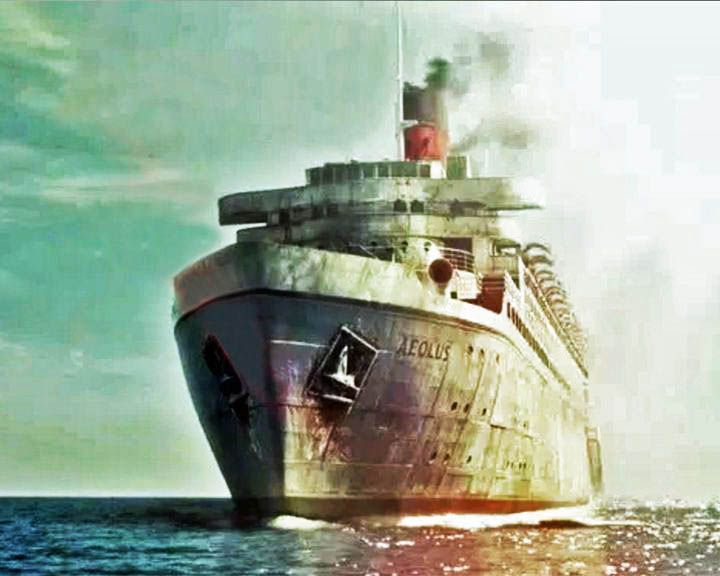 Aeolus — British cruise ship; movie set creation A mysterious ship in the British movie Triangle. The movie scenes include the exterior of the cruise liner which the director insisted on constructing to avoid shooting everything with green screens LAUNCHED: 2009, movie release → FATE: Inconclusive. |
 Amethyst, HMS — British modified Black Swan class sloop Subject of the 1957 movie Yangtse Incident, an actual event in April of 1949 during the Chinese Civil War. In the movie, she played herself. During World War II, she was deployed mostly on anti-submarine patrols and escort duties. LAUNCHED: 1943, May 18 → FATE: Scrapped January 19, 1957. |
 Archimedes, SS — British steamship First ship propelled by a screw drive. The advantages over side paddlewheel propulsion persuaded the Royal Navy to build the steam sloop-of-war HMS Rattler, the first British warship to adopt a screw propeller. LAUNCHED: 1839, October 18 → FATE: Sank in the Meuse River during a storm on March 1, 1864. |
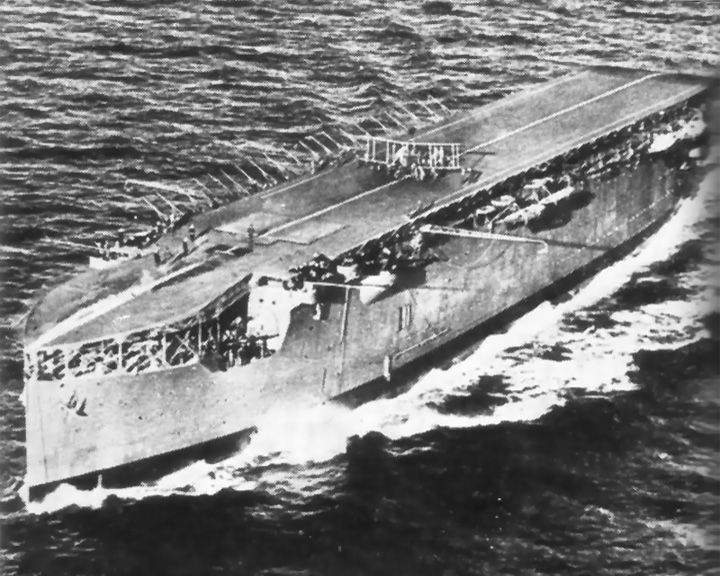 Argus, HMS — British aircraft carrier First Aircraft carrier to have a full flight deck and a lift. She was built from the incomplete Italian ocean liner Conte Rosso and served extensively in both world wars. LAUNCHED: 1917, December 18 → FATE: Scrapped December 1946. |
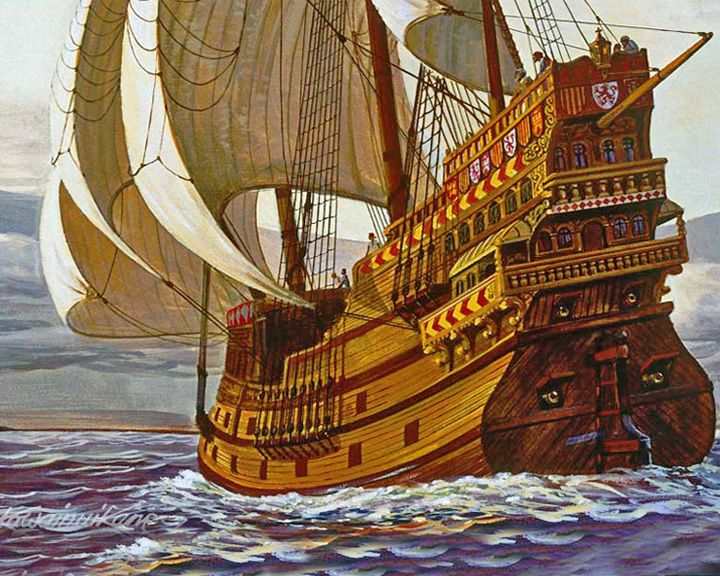 (Another (Another Ark Royal, HMS — English galleon English flagship that fought against the Spanish Armada. During the reign of James VI and I, she was renamed Anne Royal. Several British aircraft carriers have been named Ark Royal. LAUNCHED: 1587 → FATE: Accidentally sunk in April of 1636; raised and broken up in 1638. |
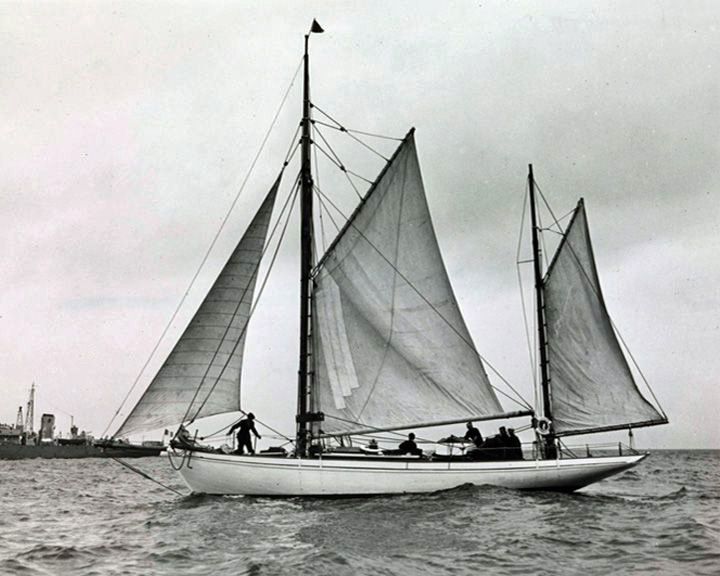 (Another (Another Asgard — British yacht She is most noted for her use in the Howth gun-running of 1914. She was used for sail training by the Irish Navy in the 1960s and as the national sail training vessel from 1969 to 1974. LAUNCHED: 1905 → FATE: The restored Asgard is on permanent display in Collins Barracks, Dublin. |
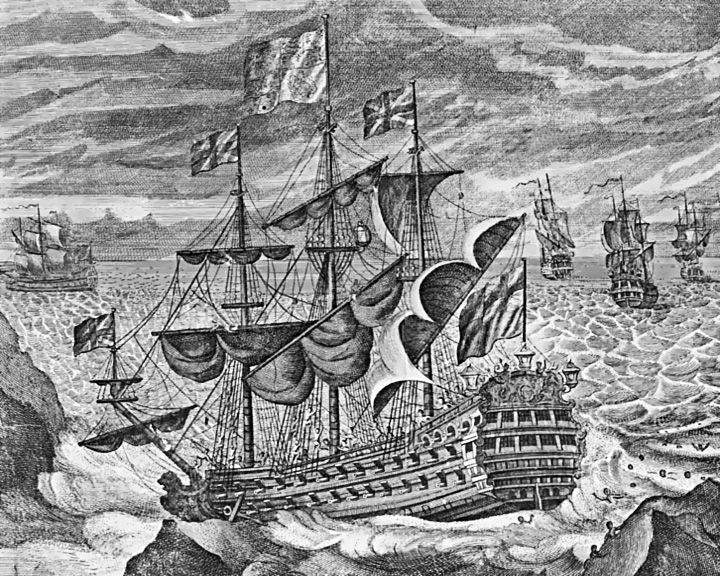 Association, HMS — British second-rate ship of the line After serving with distinction at the capture of Gibraltar, she ended up lost in a storm and wrecked with 3 other ships with the loss of nearly 2,000 lives. The rediscovery of the Association and so many historical artefacts led to legislation such as the Protection of Wrecks Act to preserve British historic wreck sites. LAUNCHED: 1697 → FATE: Wrecked of the Isles of Scilly October 22, 1707. |


|
Page 2
|
 Atlantic, RMS — English ocean liner with sails and steam One of the deadliest civilian maritime disaster in history killing 535 people. The greatest disaster for the White Star Line prior to the loss of Titanic 39 years later. LAUNCHED: 1871, June 18 → FATE: Ran onto rocks and sank off the coast of Nova Scotia April 1, 1873. |
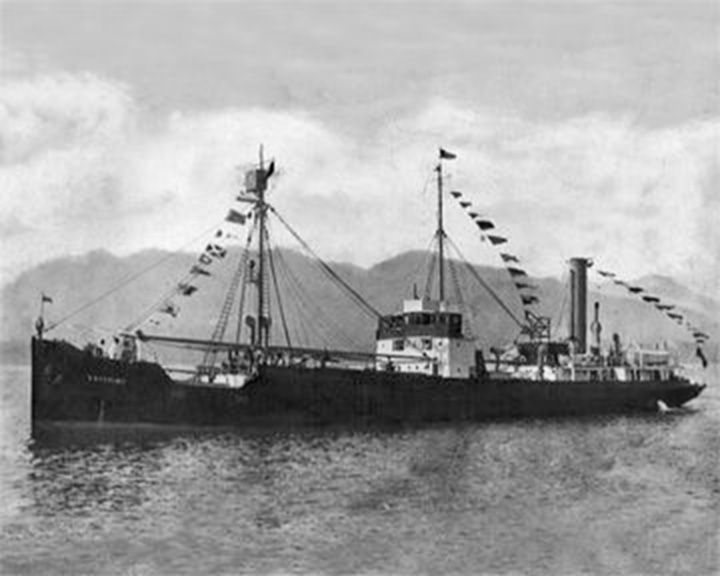 Baychimo, SS — German cargo ship, then British; steel-hulled Known as a ghost ship and seen numerous times since, her last sighting in 1969. She was taken by Great Britain as part of Germany's WW I reparations and acquired by the Hudson's Bay Company in 1921. LAUNCHED: 1914 → FATE: Abandoned and lost along the Alaska coast in November, 1931. |
 Beagle, HMS — English sloop, or brig-sloop, two-masted She carried Charles Darwin on his historic expedition beginning in 1831. Robert FitzRoy was captain during the historic round-the-world trip. In 1845 the Beagle was refitted as a static coast guard watch vessel. LAUNCHED: 1820, May 18 → FATE: Sold for scrap in 1870. |
 Belfast, HMS — British town-class cruiser One of only three surviving bombardment ships which supported the D-Day Normandy Landings in 1944 of World War II, firing probably the first or second salvo. She spent 33 days in support of the D-Day landings and fired over 4,000 6-inch and 1,000 4-inch shells. LAUNCHED: 1938, March 18 → FATE: After much preservation work, she is on exhibit, located on the River Thames next to Tower Bridge at the Port of London. |
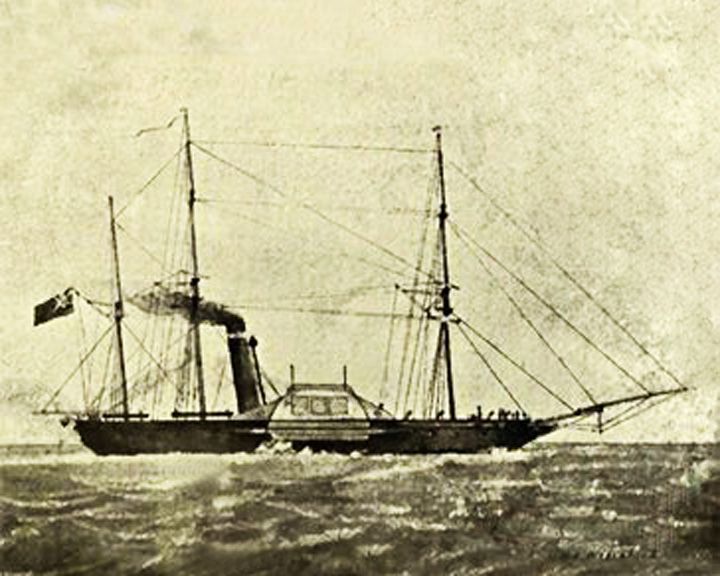 (Another (Another Birkenhead, HMS — British frigate, steamer The protocol "women and children first" originated on this sinking ship. Only 193 of the 643 people on board survived. Over the years, numerous attempts have been made to salvage the gold thought on board. LAUNCHED: 1845, December 18 → FATE: Struck a hidden reef and sank February 26, 1852. |
 (Another (Another Bluebird K7 — British hydroplane, jet powered Set seven world water speed records between 1955-1964, reaching 276.3 mph or 444.7 km/h. She was developed and piloted by Donald Campbell. LAUNCHED: 1955 → FATE: Flipped and disintegrated at high speed on Coniston Water January 4, 1967, killing Donald Campbell. |
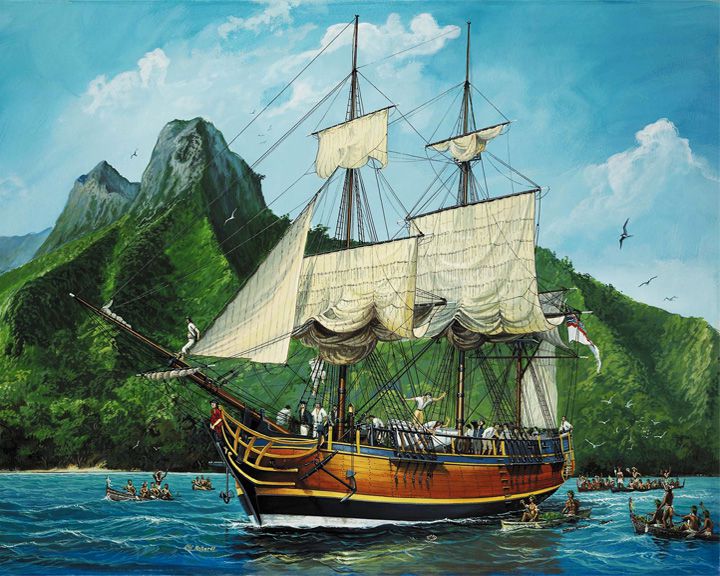 Bounty, HMS — English collier, three-mast Mutiny aboard ship, April 28, 1789, led by Fletcher Christian against Captain William Bligh. Its mission was to pick up breadfruit plants from Tahiti and transport them to the West Indies. The mutiny was dramatized in several books and movies. LAUNCHED: 1784 → FATE: Was burned by the mutineers on January 23, 1790. |
 Britannia, HMY — British yacht Former Royal Yacht of the British monarch, Queen Elizabeth II, and where Prince Charles and Diana took their honeymoon. During her service as Royal Yacht conveying members of the Royal Family and various dignitaries, she steamed 1,087,623 nautical miles or 2,014,278 km. LAUNCHED: 1953, April 18 → FATE: Decommissioned December 11, 1997, now a museum ship at Leith, Edinburgh, Scotland. |
|
Page 3
|
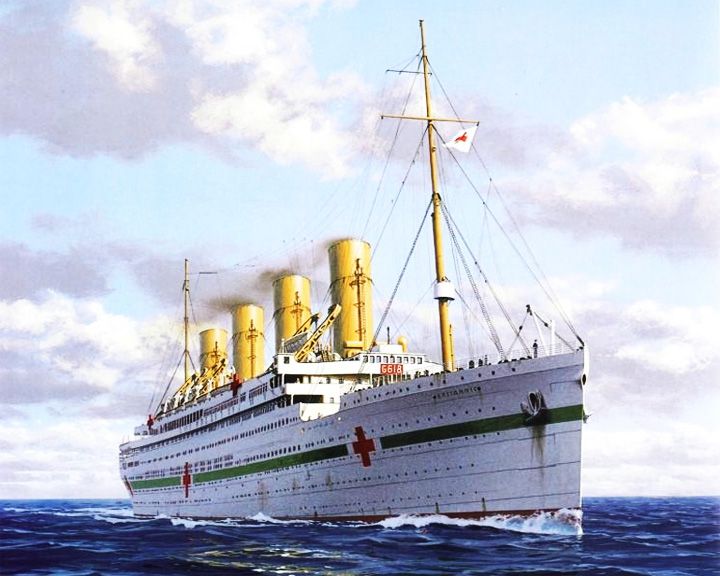 (Another (Another Britannic, HMHS — British ocean liner Largest ship lost during the World War I with the loss of 30 lives. Launched just before the start of the World War I, she was put to use as a hospital ship in 1915. With her loss, SS Bismarck was given to the White Star Line as part of post-war reparations. LAUNCHED: 1914, February 18 → FATE: Struck a mine and sank off the Greek island of Kea November 21, 1916. |
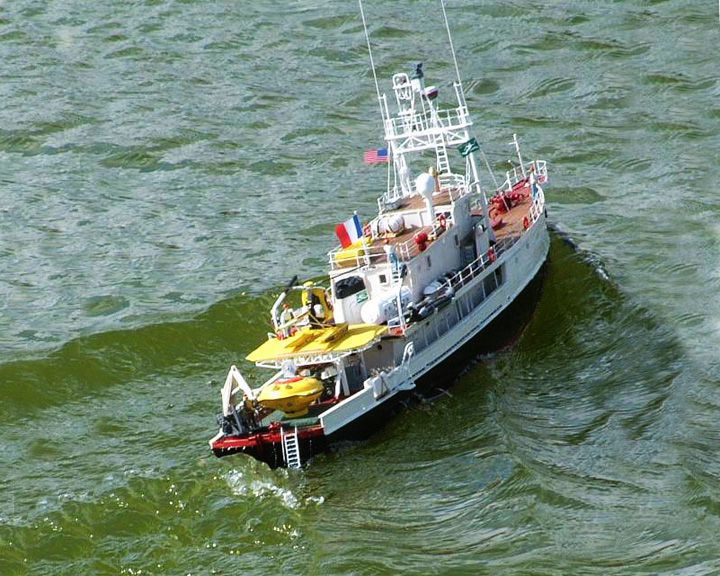 (Another (Another Calypso, RV — American minesweeper built for the British; refitted for research Oceanographer Jacques-Yves Cousteau sailed her as a mobile laboratory for field research. During World War II she served as a minesweeper and carried advanced equipment, including mini submarines. LAUNCHED: 1941, March 21, converted in 1950 → FATE: Sank in 1996, raised, neglected, and now being restored in Brittany. |
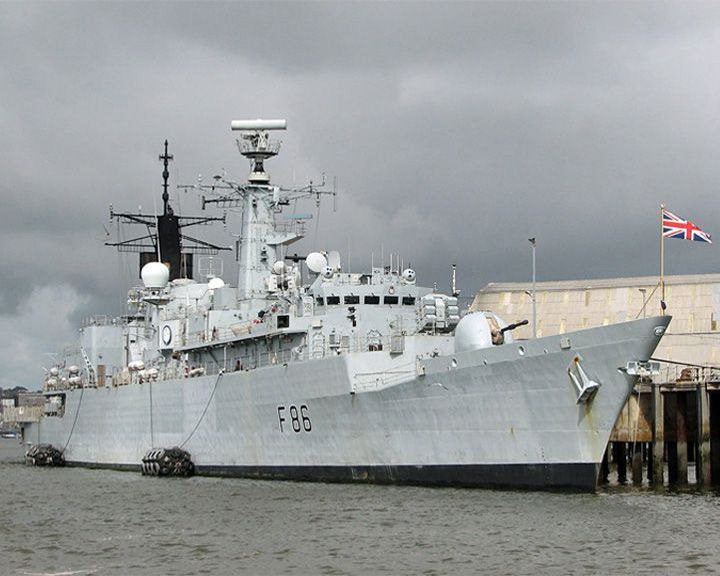 Campbeltown, HMS — American Wickes-class destroyer A most famous ship in the St. Nazaire Raid in 1942 when, packed with explosives, she was rammed into a German port and detonated. The ship and the raid were depicted in the movie Gift Horse. (See Ballantrae, HMS) LAUNCHED: 1919, January 2 as USS Buchanan; given to Britain and renamed in 1940 → FATE: Destroyed March 28, 1942 in the Saint Nazaire Raid, World War II. |
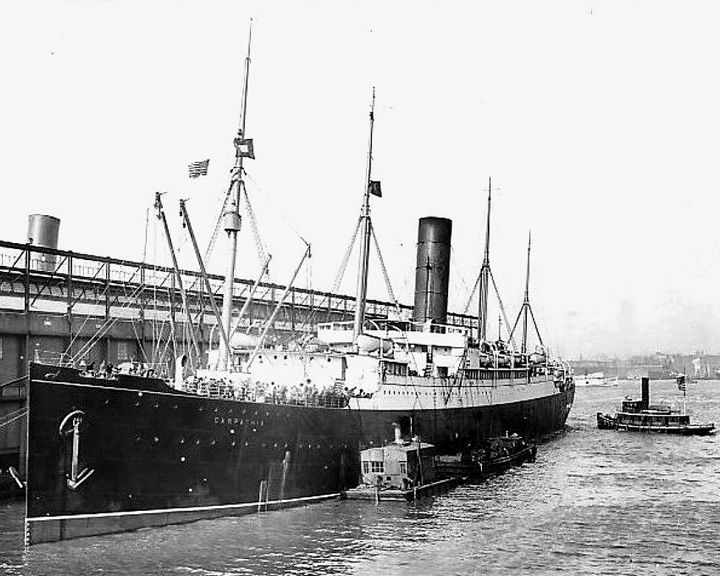 Carpathia — British ocean liner; (Cunard Line passenger steamship) Became famous for rescuing survivors of RMS Titanic on April 15, 1912. After sailing through dangerous ice fields, she arrived at the sinking Titanic at 4:00 am and took on 705 survivors from lifeboats. LAUNCHED: 1902, August 18 → FATE: Sunk in the Atlantic on July 17, 1918 during World War I by a German submarine, the fifth Cunard ship sunk in as many weeks. |
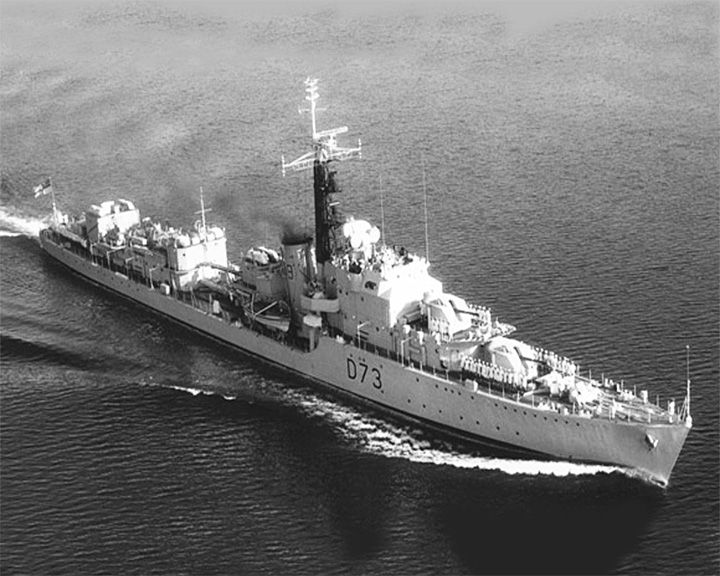 Cavalier, HMS — British C-class Destroyer Because of her high speed, she escorted the RMS Queen Mary and RMS Queen Elizabeth carrying troops across the Atlantic Ocean. In the summer of 2009 the Chatham Historic Dockyard Trust made available accommodation on board the ship for youth groups who wish to stay on board and experience life on board a Royal Naval Destroyer. LAUNCHED: 1944, April 18 → FATE: Preserved as a museum ship since 1998, now at the Chatham Historic Dockyard |
 (Another (Another Challenger, HMS — British corvette; steam-assisted Undertook the first global marine research expedition. She was the flagship of the Australia Station between 1866 and 1870. LAUNCHED: 1858, February 18 → FATE: Broken up for her copper end in England in January, 1921. |
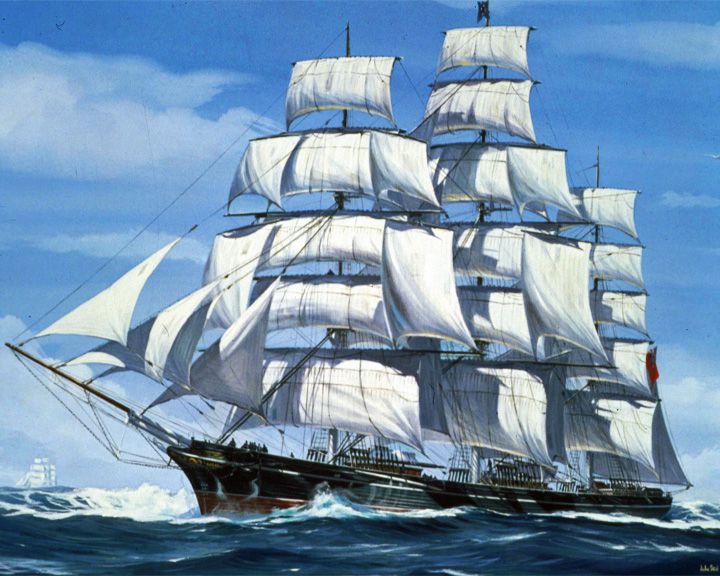 Champion of the Seas — English clipper ship On her maiden voyage, she set a record for the fastest run in 24 hours of 465 nautical miles or 861 km. She was the passenger ship built for the run from Liverpool, England to Melbourne, Australia. LAUNCHED: 1854, April 18 → FATE: Abandoned off Cape Horn in leaking condition in 1877. |
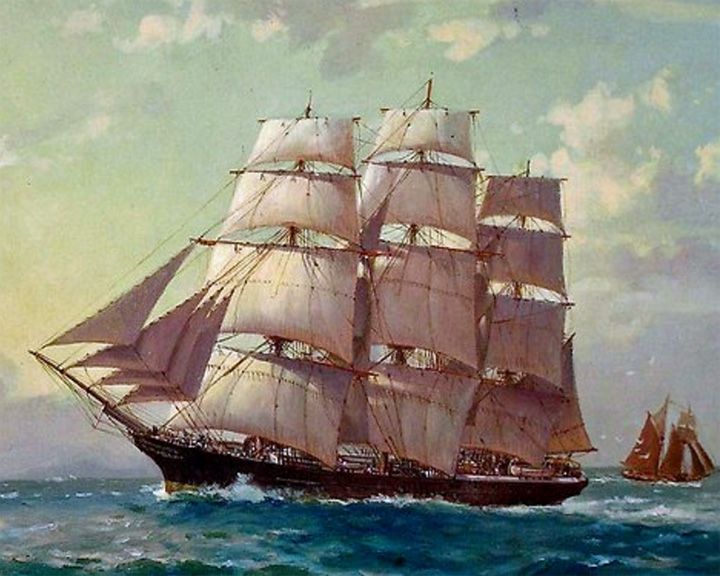 City of Adelaide — English clipper ship The world's oldest surviving clipper ship. From 1864 to 1887, she played an important part in the immigration of Australia. She is now part of the National Historic Ships of the United Kingdom. LAUNCHED: 1864, May 18 → FATE: Out of service since 1948, current being restored. |
|
Page 4
|
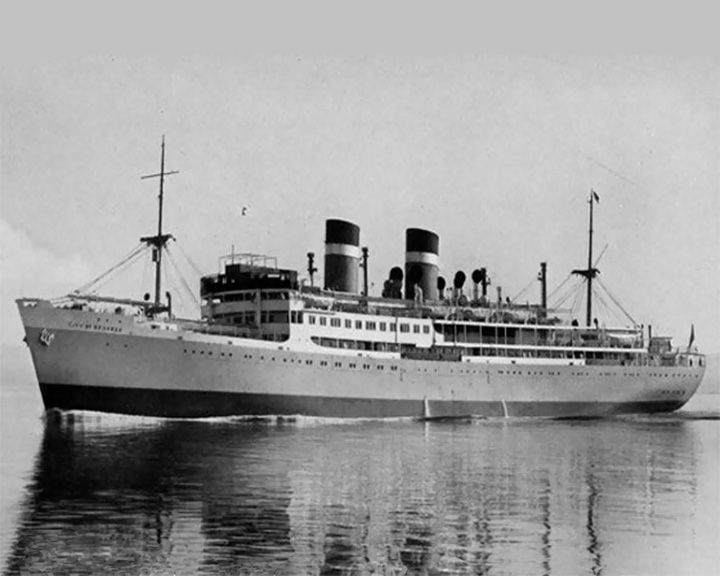 City of Benares, SS — British steam passenger ship The ship taking English evacuated children to Canada torpedoed during World War II by a German submarine. 260 of the 407 people on board were lost including 77 children. The sinking reportedly inspired actress and inventor Hedy Lamarr to develop and patent a system of spread spectrum radio as a means to guide anti-ship torpedoes. LAUNCHED: 1935, August 5 → FATE: Sunk September 18, 1940. |
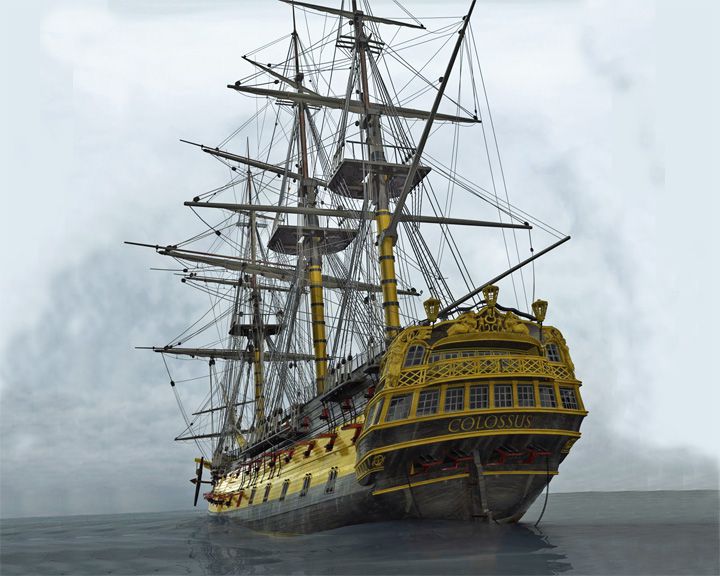 Colossus, HMS — British third-rate ship of the line After many battles and much glory, she lost her way and ran aground and sunk with one fatality. In 1974, fragments from the Colossus were discovered and reconstructed and are now displayed at the British Museum in London. LAUNCHED: 1787, April → FATE: Wrecked of the Isles of Scilly December 10, 1798. |
 Comet, PS — British paddle steamer First commercially successful steamboat service in Europe on the River Clyde between Glasgow and Greenock in Scotland. The success of this passenger service quickly inspired competition and the Comet was soon outclassed by newer steamers. LAUNCHED: 1812, August 18 → FATE: Wrecked in strong currents at Craignish Point near Oban on December 13, 1820. |
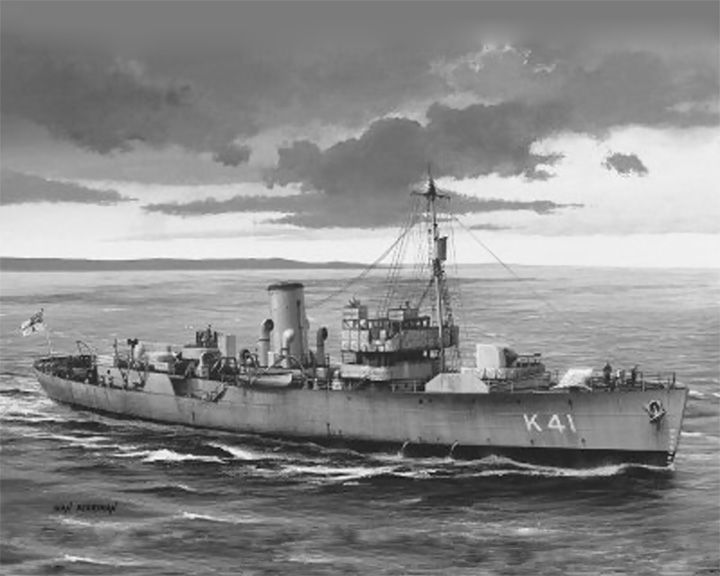 Compass Rose — British Flower-class corvette The ship portrayed in the movie The Cruel Sea, about the conditions in which the Battle of the Atlantic was fought between the Royal Navy and Germany's U-boats. The movie ship was portrayed by the Flower-class corvette HMS Coreopsis. LAUNCHED: 1953 → FATE: Inconclusive. |
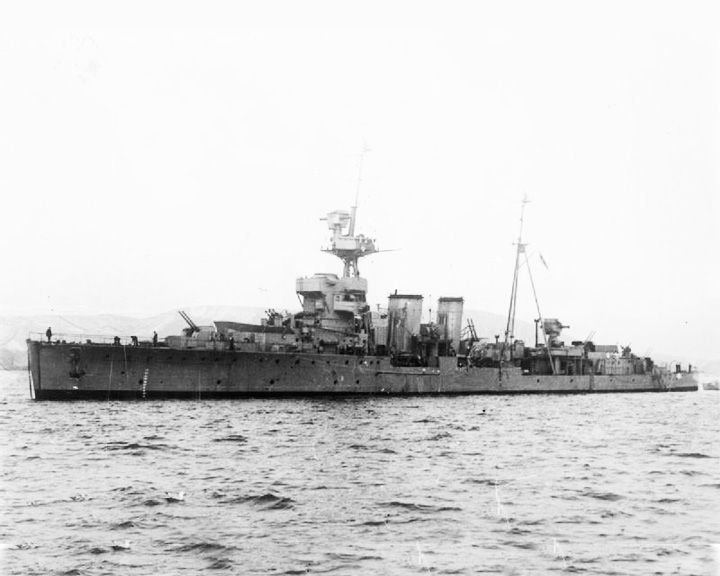 Curacoa, HMS — British light-cruiser Accidentally sliced in half and sunk by the ocean liner RMS Queen Mary, with the loss of 337 men. Her demise came while escorting convoy ships during World War II. Those who witnessed the collision were sworn to secrecy due to national security concerns. LAUNCHED: 1917, May 5 → FATE: Sunk in collision with HMS Queen Mary, 1942, October 2. |
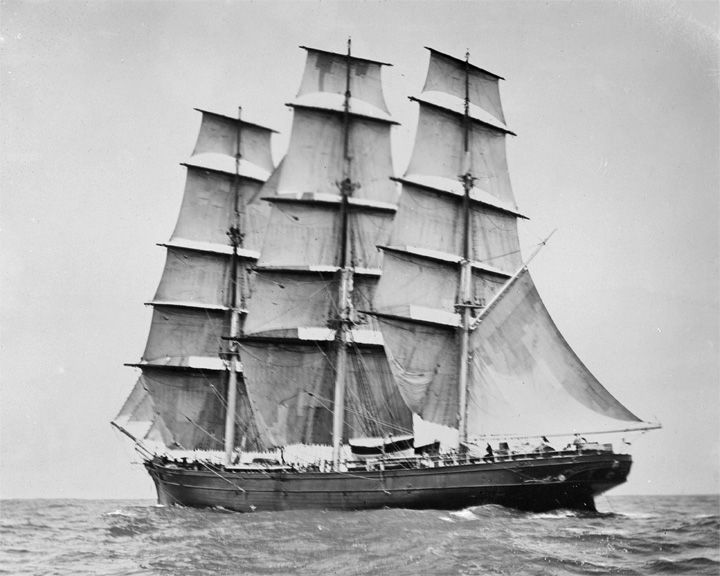 (Another (Another Cutty Sark — English clipper ship Lost China-to-London race to ship called Thermopylae. She is one of three remaining original composite construction (wooden hull on an iron frame) clipper ships from the nineteenth century. LAUNCHED: 1869, November 18 → FATE: Now preserved in dry dock in Greenwich, England. |
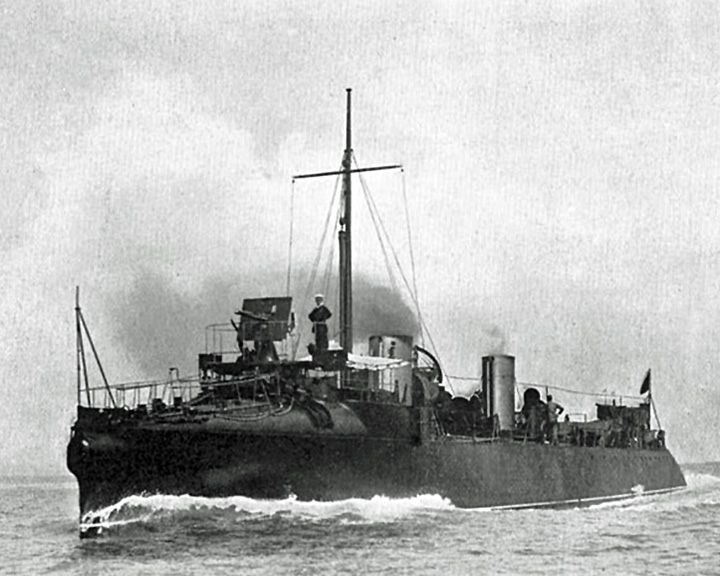 Darling, HMS — British torpedo boat destroyer First destroyer-type ship. Created to defend against torpedo boats. She was described at the time as the "fastest boat ever" having achieved a speed over 28 knots. LAUNCHED: 1893, November 18 → FATE: Scrapped in 1912. |
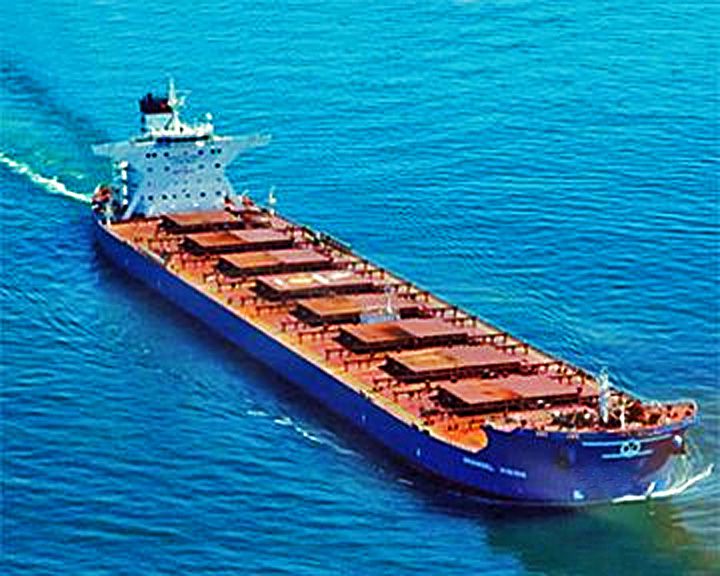 Derbyshire, MV — British cargo ship, oil-ore Largest British ship ever to have been lost at sea. All 42 crew members and two wives were lost with the ship during Typhoon Orchid in 1980. LAUNCHED: 1976, June → FATE: Sank south of Japan September 9, 1980. |
|
Page 5
|
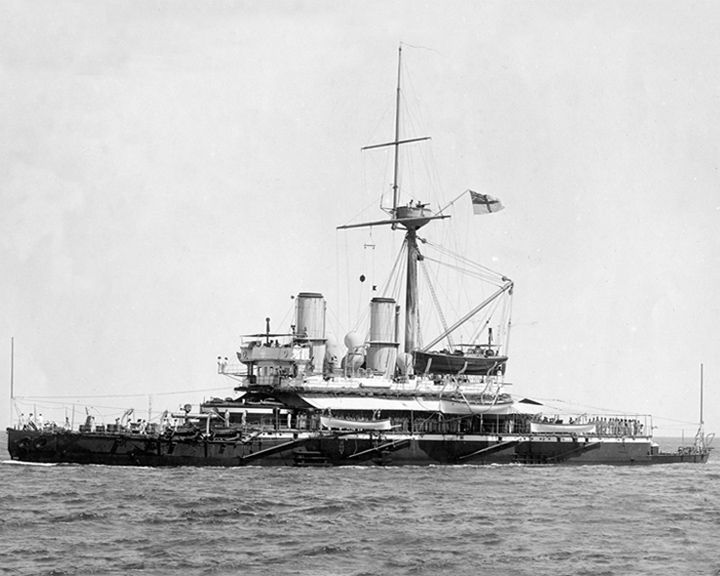
Devastastion, HMS — British Devastation-class ironclad The first ocean-going capital ship not carry sails, and the first with the entire main armament mounted on top of the hull rather than inside it. Originally conceived as a ocean-going breastwork monitor, she was redesignated as 2nd Class Turret ships in 1886 and finally as 2nd Class Battleships by the 1900. LAUNCHED: 1874 → FATE: Was scrapped in 1908. |
 Discovery — British three-masted barque The ship that carried Scott and Shackleton on their first successful journey to the Antarctic. She was locked in the ice of the Antarctic for two years. The ship was eventually freed in February, 1904 by the use of controlled explosives. LAUNCHED: 1901, March 18 → FATE: Museum ship in Dundee, Scotland. |
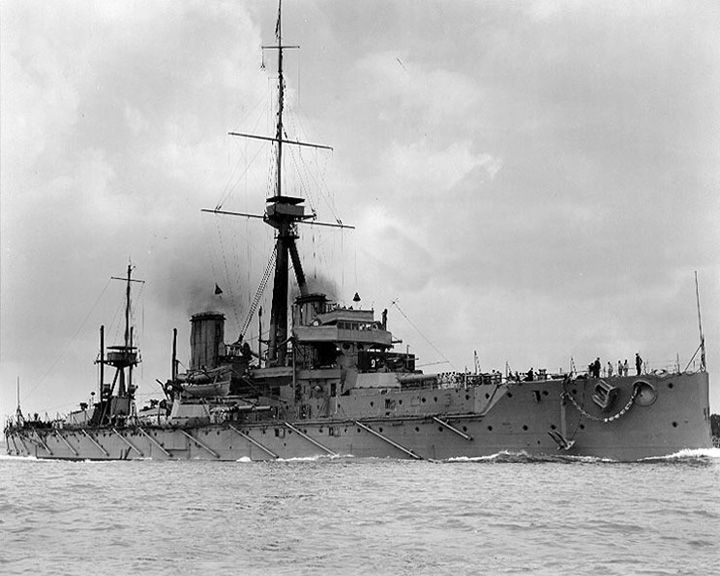 Dreadnought, HMS — British dreadnought battleship First "all-big-gun" armament and steam turbine propulsion. She revolutionized naval power and started a naval arms race. LAUNCHED: 1906, February 18 → FATE: Sold for scrap in 1923. |
 Driver, HMS — British side-wheeler paddle sloop First steamship to circumnavigation the globe. She was the first steamship to visit New Zealand, arriving January 1846, and was involved in the New Zealand Wars. LAUNCHED: 1840, December 18 → FATE: Wrecked on Mayaguana Island on August 3,1861. |
 Empire Windrush, MV — German cruise ship captured by England in May of 1945 Carried 493 West Indian immigrants from Jamaica wishing to start a new life in the England on June 22, 1948. Before World War II, she was used for cruises by the Nazi Party to reward party members for services to the Party. Image shown is of sister-ship Empire Doon. LAUNCHED: 1930, December 18 → FATE: Sank in the Mediterranean Sea in March 30, 1954. |
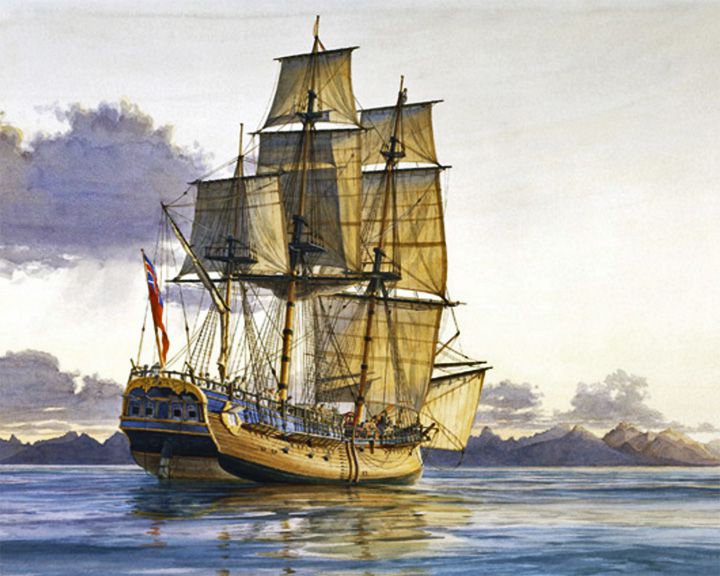 (Another (Another Endeavour, HMS — British collier, three-masted; refitted in 1768 for the expedition James Cook's ship during his voyage to explore the Pacific Ocean and Terra Australis Incognita. She became the first ship to reach the east coast of Australia at Botany Bay in April 1770, and went on to circumnavigate the world. LAUNCHED: 1764, June → FATE: Later renamed Lord Sandwich. Scuttled in a blockade of Narragansett Bay, Rhode Island, in 1778. |
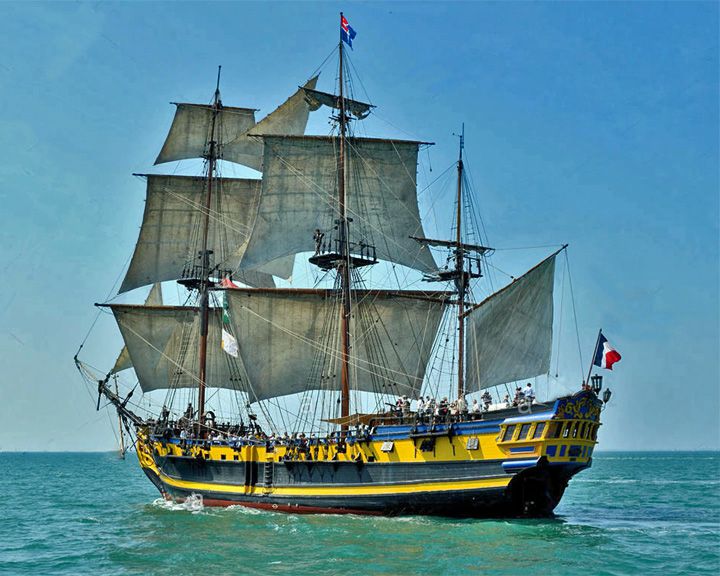 Etoile du Roy — British frigate, sixth-rate Stand-in for several different ships for the British TV series Horatio Hornblower, 1998-2003. The three-masted frigate was built specifically to represent a generic Nelson-age warship, with her design inspired by HMS Blandford built in 1741. LAUNCHED: 1997, September → FATE: Sold to a French company and now on exhibit at Saint-Malo, Brittany. |
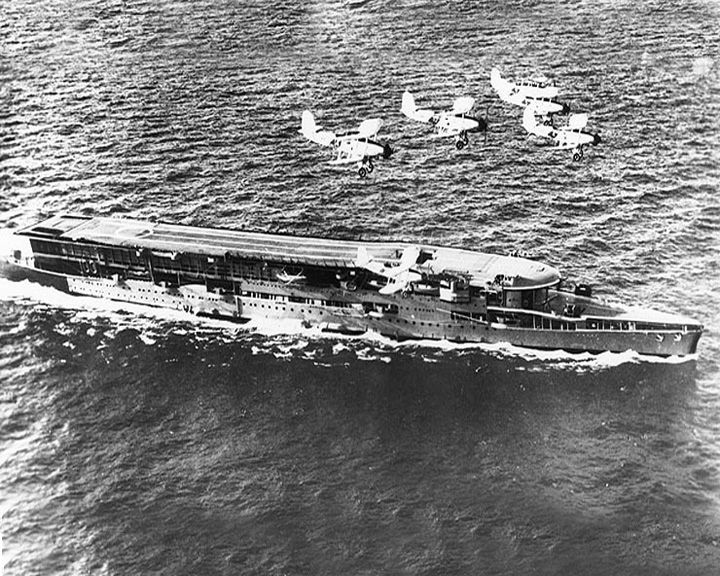 Furious, HMS — British battlecruiser (modified while under construction as an aircraft carrier) First aircraft carrier; her forward turret was removed and a flight deck was added in its place. Spent last of World War I and much of World War II as an aircraft ferry. LAUNCHED: 1916, August 18 → FATE: Sold for scrap in 1948. |
|
Page 6
|
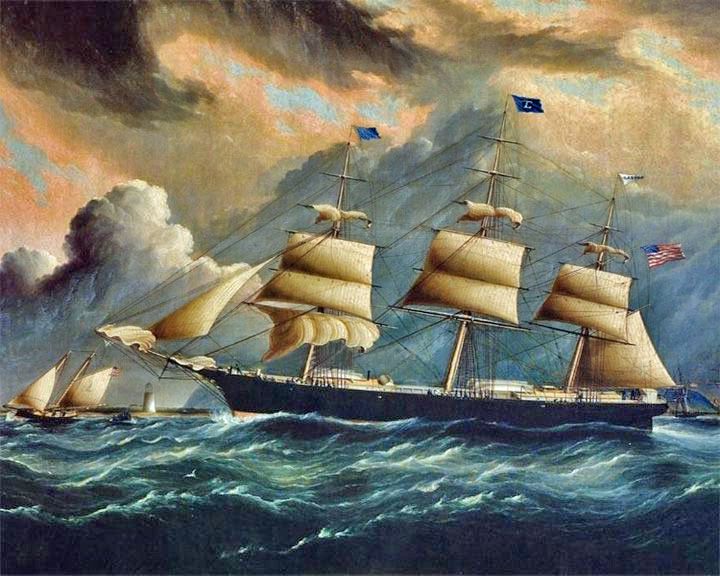 (Another (Another Gaspée — English single-masted sloop-of-war, used as a fast revenue cutter Subject of the "Gaspée Affair," the torching of the ship by a group of American colonialists, leading up to the American Revolution. The city of Warwick, RI commemorates the Gaspée Affair with a festival and parade, including burning the Gaspée in effigy. LAUNCHED: 1764, January → FATE: Looted and burned in Narragansett Bay June 9, 1772. |
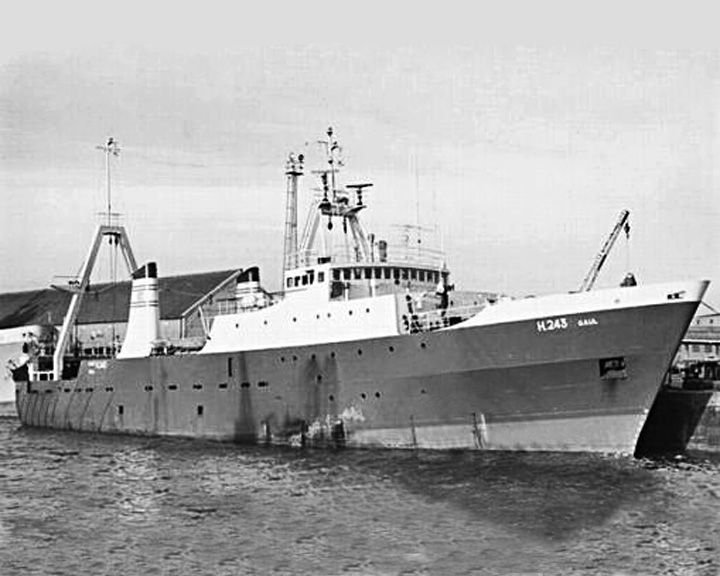 Gaul — English fishing trawler Worst peacetime maritime disaster to befall the UK fishing fleet. No distress signal was received and her loss was not realised until days later. 36 crew were lost. LAUNCHED: 1971, December 18 → FATE: Mysteriously sank in the Barents Sea, north of Norway February, 1974. |
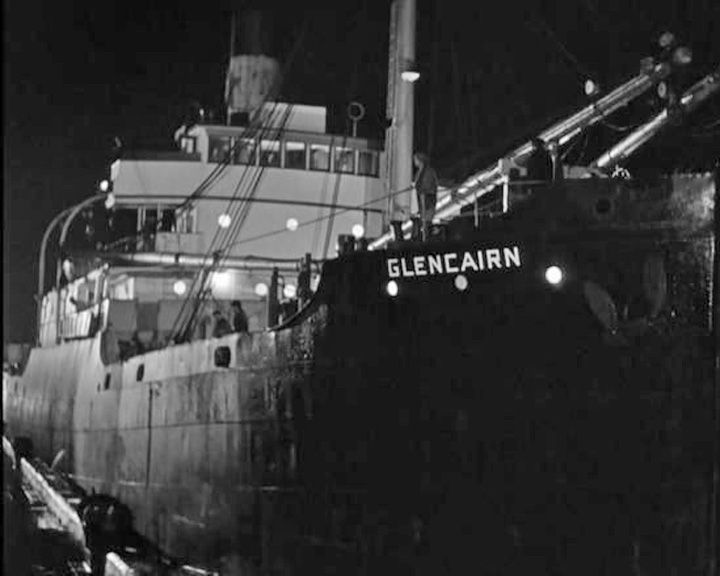 Glencairn, SS — British tramp steamer In the movie The Long Voyage Home about the men on board on the long voyage home from the West Indies to Baltimore and then to England. Nine prominent American artists, all painters, were hired to construct the dramatic scenes during the film's production. LAUNCHED: 1940, for the movie → FATE: Inconclusive. |
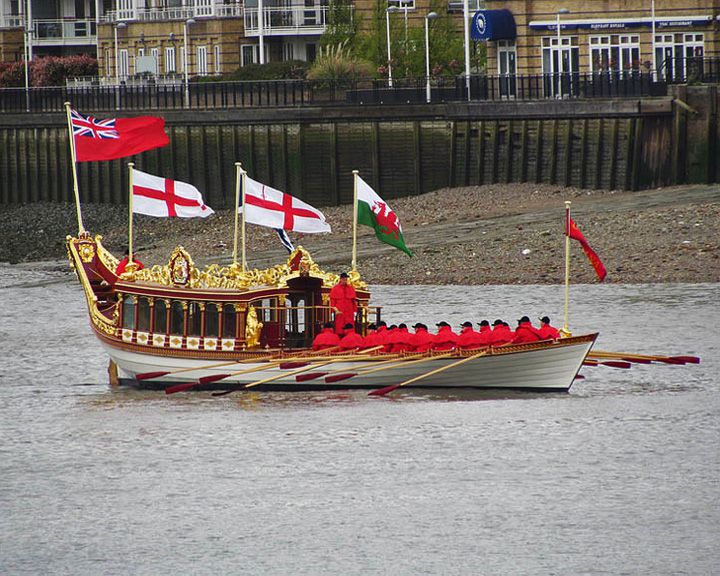 Gloriana — English royal barge, or rowbarge The lead vessel of the flotilla celebrating Queen Elizabeth II's Diamond Jubilee, June 3, 2012. She is powered by 18 oarsmen, and can carry an additional 34 passengers and crew. LAUNCHED: 2012, April 18 → FATE: Still afloat. |
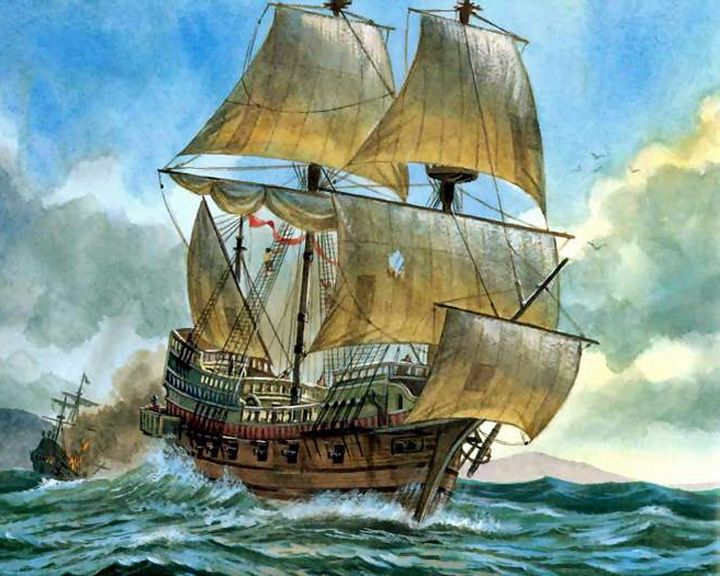 Golden Hind — English galleon Second ship to circumnavigation of the globe between 1577 and 1580, captained by Sir Francis Drake. Several replicas were built, the latest the Golden Hinde lauched in 1973. LAUNCHED: 1576, probably → FATE: In dry dock at Deptford, England as a museum piece, rotted away after decades around 1650. |
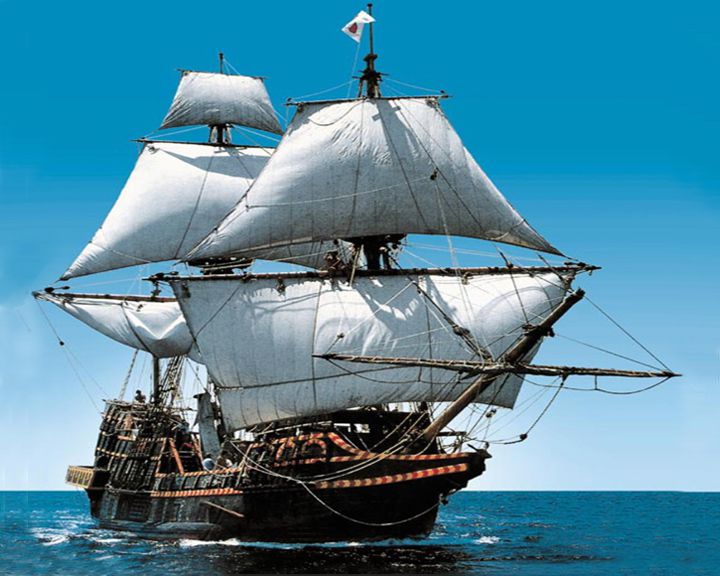 Golden Hinde — English galleon A full-size replica of the 1577 Golden Hind and appeared in several movies. She has travelled a distance equal to more than five times around the globe. Like Francis Drake's ship, she has circumnavigated the globe. LAUNCHED: 1973 → FATE: Since 1996 she has been berthed at St Mary Overie Dock, Southwark, London. |
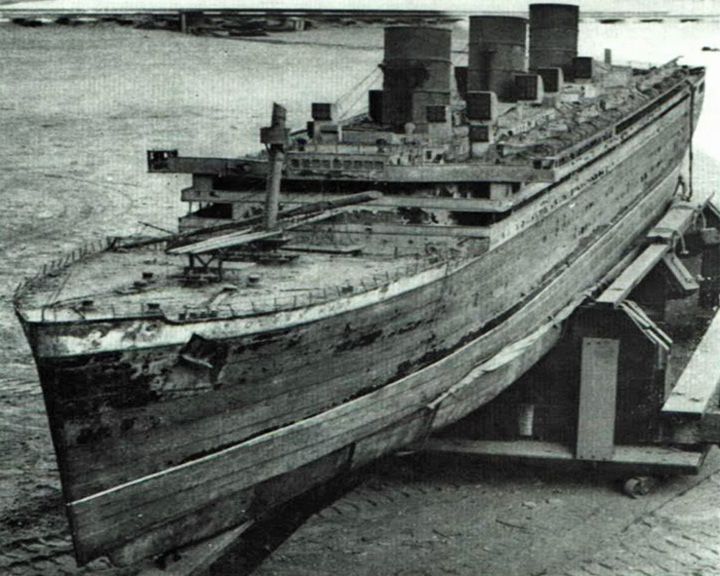 Goliath, RMS — British ocean liner Fiction ocean liner in the movie Goliath Awaits. The interiors of Goliath were filmed aboard the RMS Queen Mary in Long Beach, California. LAUNCHED: 1981, movie release → FATE: Inconclusive. |
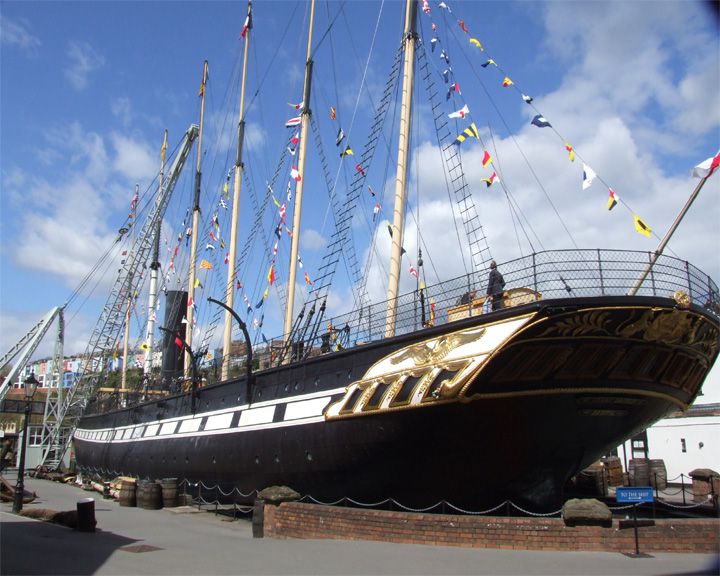 (Another (Another Great Britain, SS — British steamship, passenger ship First steamer to cross the Atlantic. Also first built of iron and with a screw propeller. She ran aground in 1846 and was sold for salvage, repaired and revised. In 1881 she was converted to sail. In 1937 she was retired and scuttled. In 1970 she was recovered and eventually restored as a museum ship. LAUNCHED: 1845, July 18 → FATE: Now a museum ship in Bristol Harbour. |
|
Page 7
|
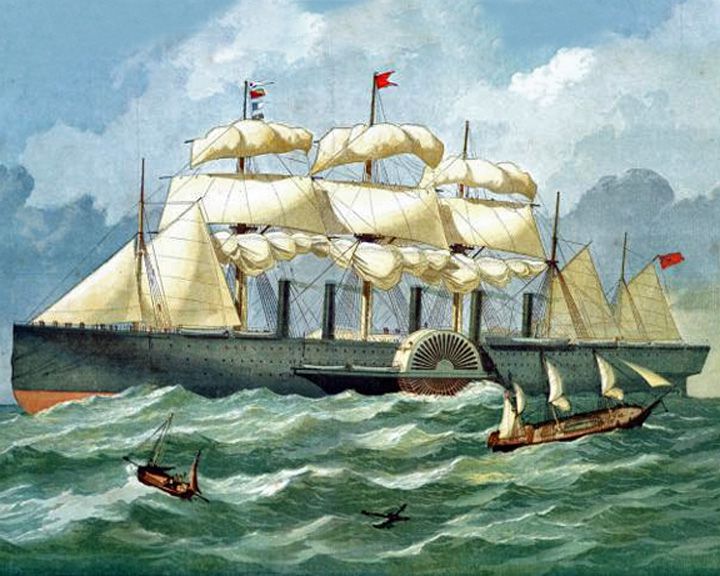 (Another (Another Great Eastern, SS — British iron paddle steamboat, side-wheeler with sails The world's largest steamship; successfully laid cable across the Atlantic Ocean. She completed 45 crossings in eight years; then she was used for carrying mail, then troops. LAUNCHED: 1858, January 18 → FATE: Broken up for scrap at Rock Ferry on the River Mersey in 1889. |
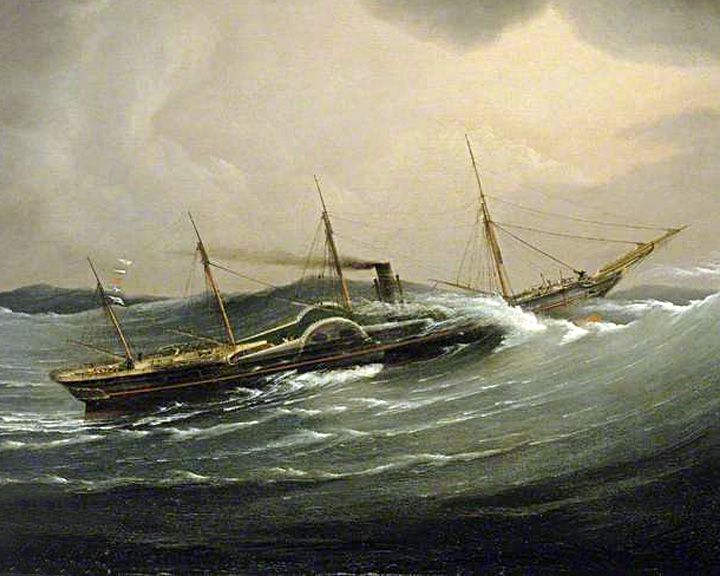 Great Western, SS — British paddle steamboat, side-wheeler First paddle ship built for crossing the Atlantic; completed the crossing in April of 1838. In later years, she was used as a showboat, a floating palace/concert hall and gymnasium. LAUNCHED: 1837, July 18 → FATE: Taken out of service December of 1846, she was broken up in 1856. |
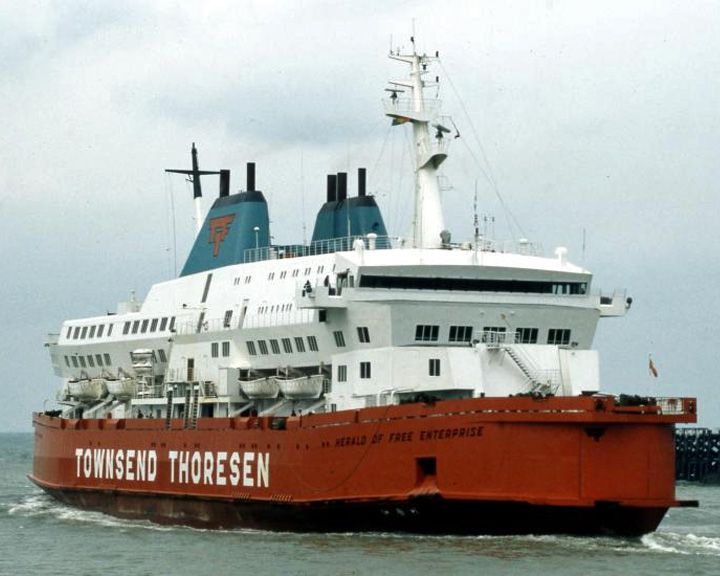 (Another (Another Herald of Free Enterprise, MS — British roll-on/rolll-off ferry Capsized moments after leaving the Belgian port, killing 193 passengers and crew, the highest death-count of any peacetime British maritime disaster since 1919. The ship owners, Townsend Thoresen, re-branded the company as P&O European Ferries, repaint the fleet's red hulls in navy blue and remove the TT logo from the funnels. LAUNCHED: 1980 → FATE: Because deck doors were left open, she filled with water and capsized March 6, 1987; was raised April 1987 and scrapped in 1988. |
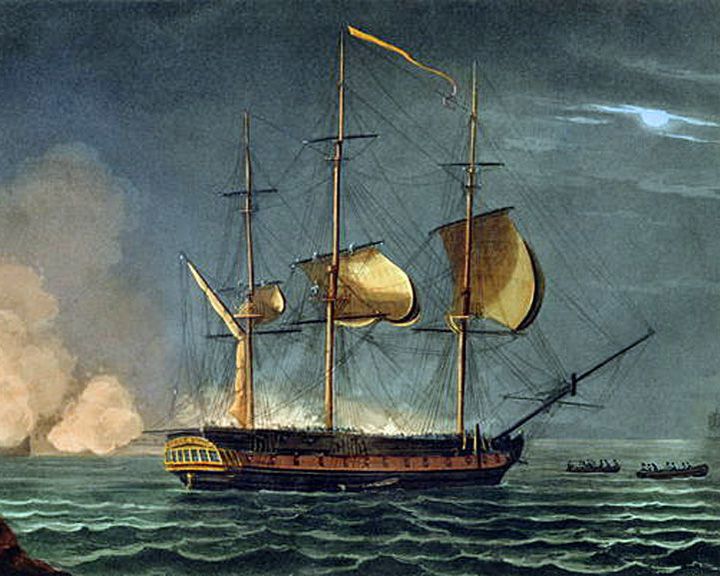 Hermione, HMS — British frigate, fifth-rate Notorious for having the bloodiest mutiny in British naval history. Mutineers gave her to the Spaniards in 1797 who put her in service as Santa Cecilia. She was retaken by the British in 1799 and renamed the Retaliation. LAUNCHED: 1782, September → FATE: Broken up at Deptford in June 1805. |
 Hero, HMAS — British Leander-class frigate Setting for the popular British television series Warship, from 1973-1977. Seven different frigates played the role of HMS Hero, all were repainted with the pennant number F42 of HMS Phoebe, the main warship used for filming. LAUNCHED: 1973 → FATE: Inconclusive. |
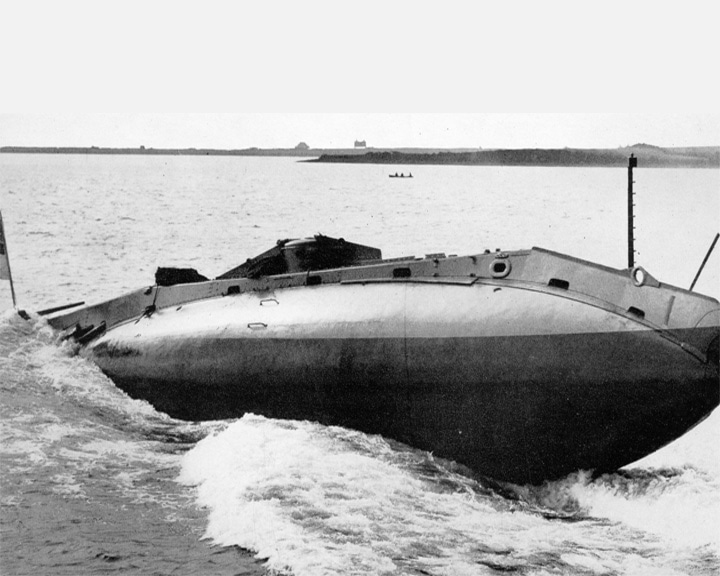 Holland I, HMS — British submarine The first submarine commissioned by the Royal Navy. While being towed to the scrapyard she sank in bad weather off the coast of Eddystone lighthouse. LAUNCHED: 1901, October → FATE: On display at Royal Navy Submarine Museum, Gosport. |
 Hood, HMS — British battle cruiser Last battle cruiser built by Britain. Of the 1,418 aboard, only three men survived. LAUNCHED: 1918, August 18 → FATE: Sunk by the German battleship Bismarck at the Battle of the Denmark Strait May of 1941. |
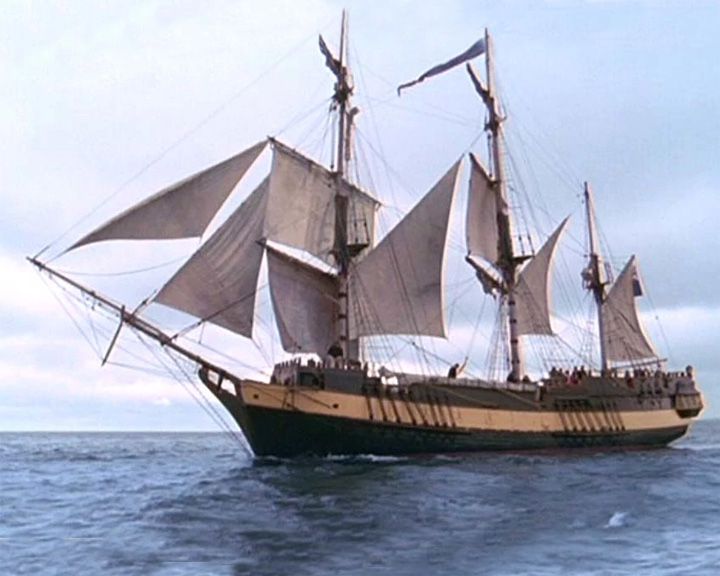 Hotspur, HMS — British sloop-of-war Ship of Horatio Hornblower in the book series and British TV series Hornblower and the Hotspur by C. S. Forester. In the TV series, she is captured by the French. After Hornblower and the crew later discover the ship, they succeed in retaking it. LAUNCHED: 1962, for the book; 1988 2003 for the TV series → FATE: Unknown. |
|
Page 8
|
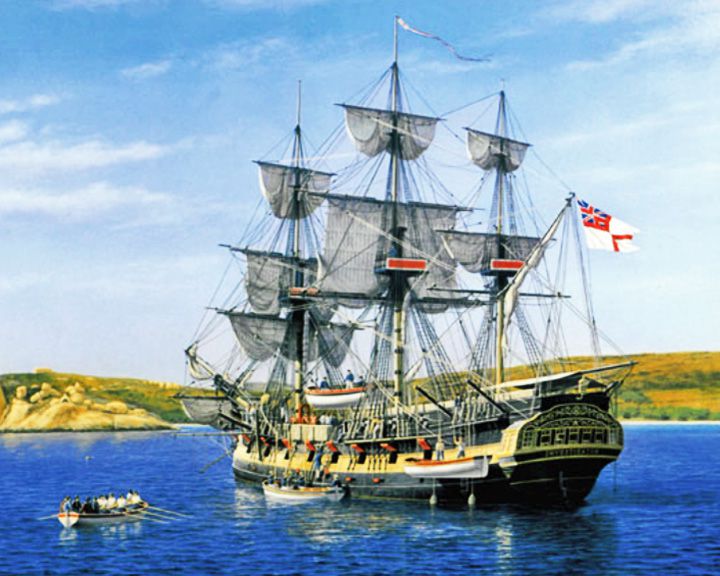 Investigator, HMS — British collier, then in 1801 converted to a survey ship. The first ship to circumnavigate Australia. The Royal Navy sold her in 1810 and she returned to mercantile service under the name Xenophon. LAUNCHED: 1795 → FATE: Broken up about 1872. |
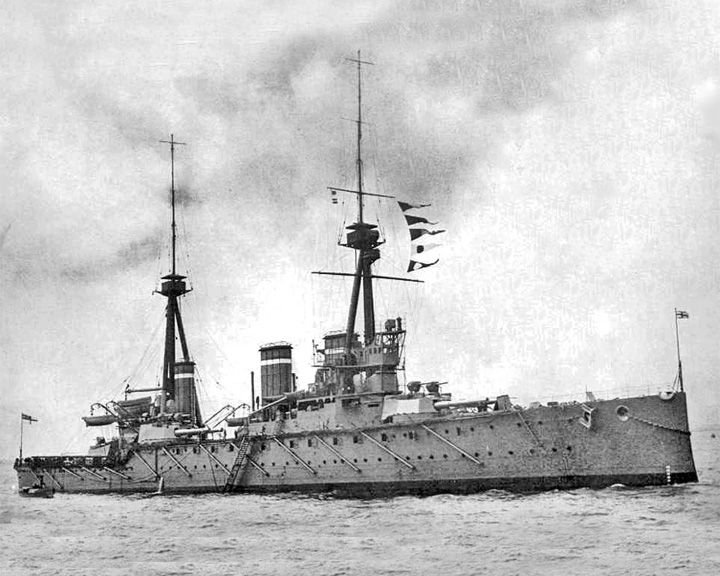 Invincible, HMS — British battlecruiser First battle cruiser to be built by any country in the world. She is one of seven ships named Invincible in the British navy from 1747 to the present. LAUNCHED: 1907, April 18 → FATE: Sunk by the German battleship SMS Lützow at the Battle of Jutland, May 31, 1916. |
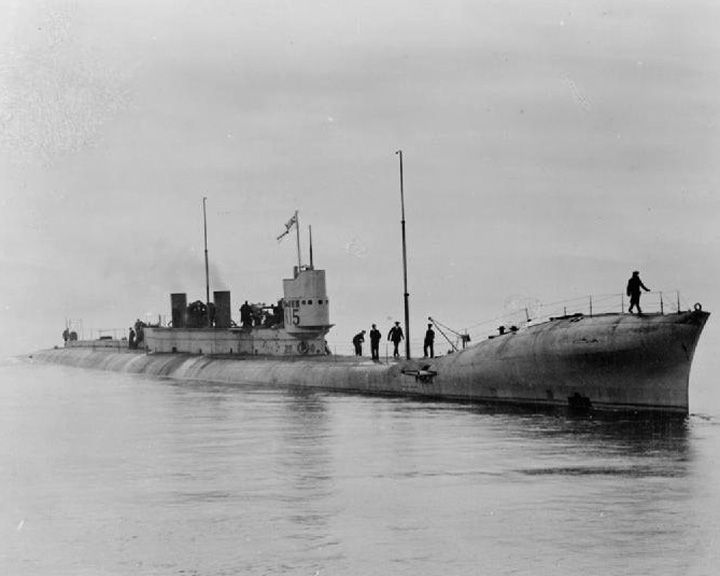 K-13 — British K-class submarine The first in the class of the steam-powered submarines. She sank in an accident during sea trials in early 1917 and was salvaged and recommissioned as HMS K22. 32 people died in the accident and 48 were rescued. LAUNCHED: 1916, November 11 → FATE: Sold for scrapping December 16, 1926 in Sunderland. |
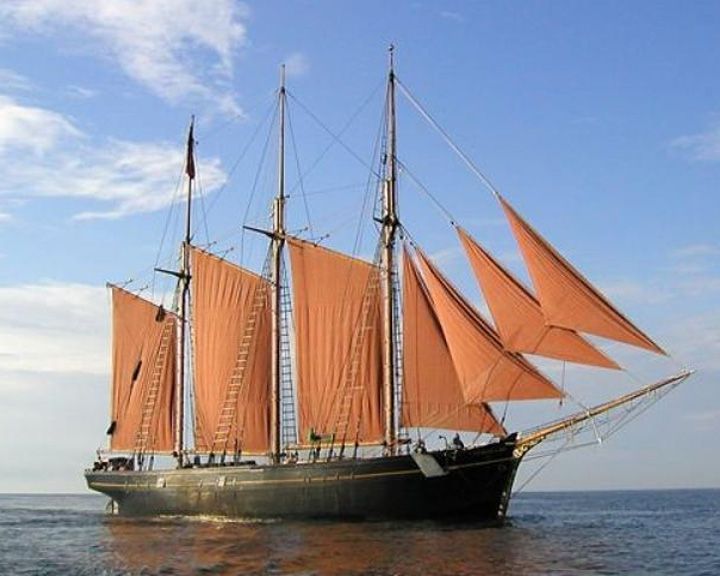 Kathleen and May — British three masted schooner Last remaining British built wooden hull three-masted top sail schooner. Originally equipped with the first known fitting of Appledore roller reefing. After years of service, during restoration in 2000, 70% of the original planking was stripped from the frames, enabling most of her internal timbers to later be refitted. LAUNCHED: 1900, April → FATE: Restored and based in Bideford on the River Torridge. |
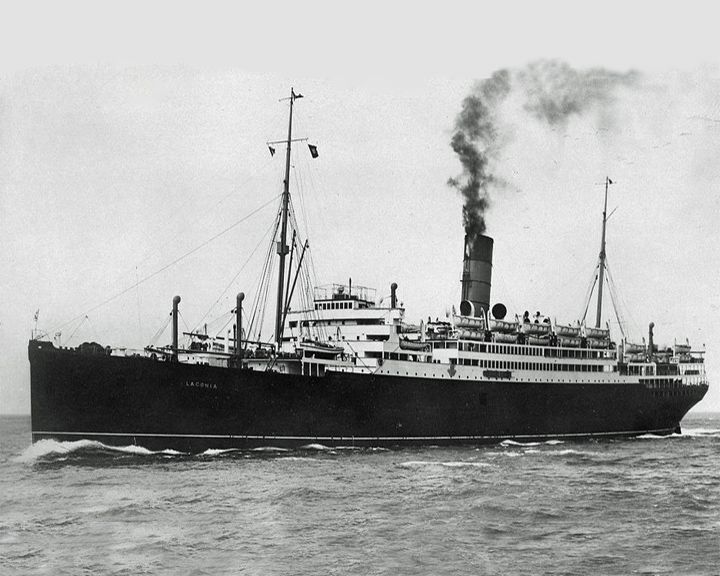 Laconia, RMS — British ocean liner, then converted to a troop ship After a torpedo attack, a dramatic rescue of the ship's passengers turned to disaster and became known as the Laconia incident. U.S. planes attacked the several German U-boats trying to rescue its 2,732 passengers and crew most of whom were abandoned by the subs, resulting in a loss of over 1,649 people. The sinking was portrayed in the 2011 British TV movie. LAUNCHED: 1921, April 18 → FATE: Sunk by German submarine U-156 off the coast of West Africa, September 12, 1942. |
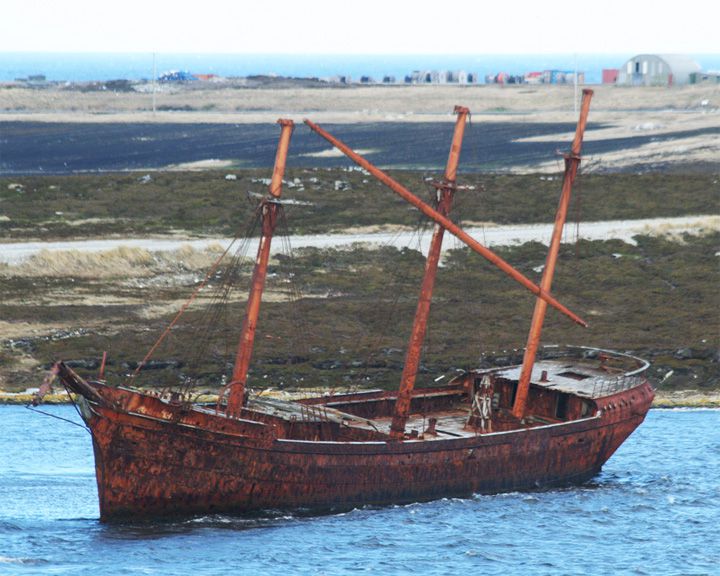 (Another (Another Lady Elizabeth — British 3-masted iron barque The hulk of the ship is the only semi-intact hulk left in the harbours of the Falkland Island. After being condemned in 1913, she served as a timber warehouse alongside the East Jetty. In February 1936 she broke her moorings in a storm and drifted to her present location. LAUNCHED: 1879, June 6 → FATE: Her remains now lie at the bottom of Whale Bone Cove harbour, Stanley, Falkland Islands. |
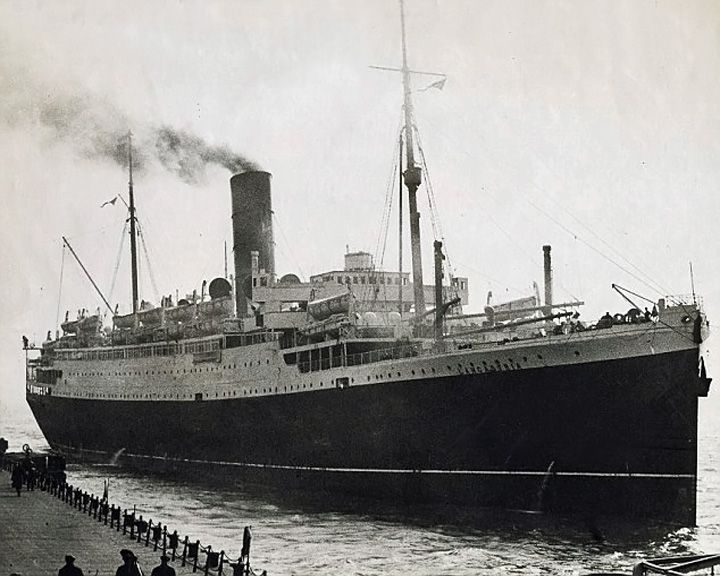 Lancastria, RMS — British ocean liner Worst single loss of life in British maritime history and the bloodiest single engagement for UK forces in World War II. Over 4000 people were lost while evacuating British nationals and troops from France. LAUNCHED: 1922, June → FATE: Sunk off the French port of St. Nazaireon June 17, 1940. |
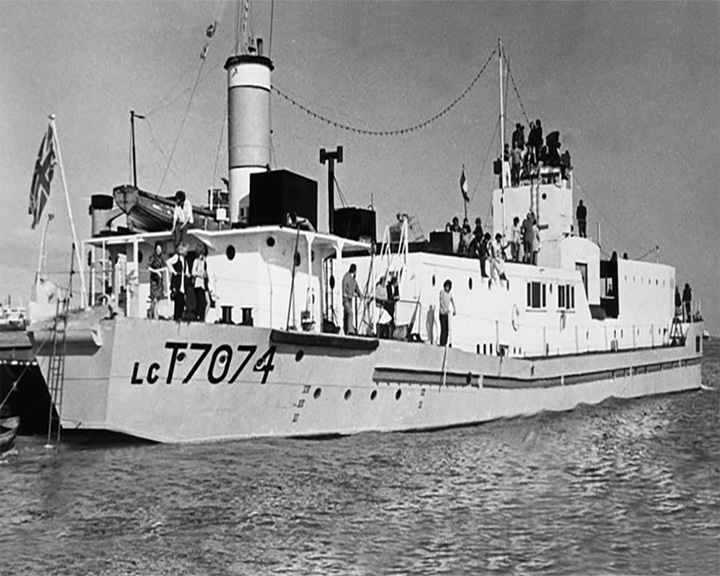 LCT7074, HM — British landing craft, tank (LCT) The last amphibious assault ship in the United Kingdom for landing tanks, other vehicles and troops on beachheads. De-commissioned in 1947 she was renamed Landfall and became the club ship for the Master Mariners’ Club of Liverpool. The craft was later converted into a riverfront nightclub. LAUNCHED: 1944, April 4 → FATE: Salvaged and restored by 2020, then moved to a permanent display at Portsmouth's The D-Day Story museum. |
|
Page 9
|
 Lightning, HMS — British torpedo boat The first ship to launch self-propelled torpedos. She was used exclusively with HMS Vernon, a torpedo school ship at the Royal Navy's Torpedo Branch at Portsmouth, England. LAUNCHED: 1876 → FATE: Scrapped in 1896. |
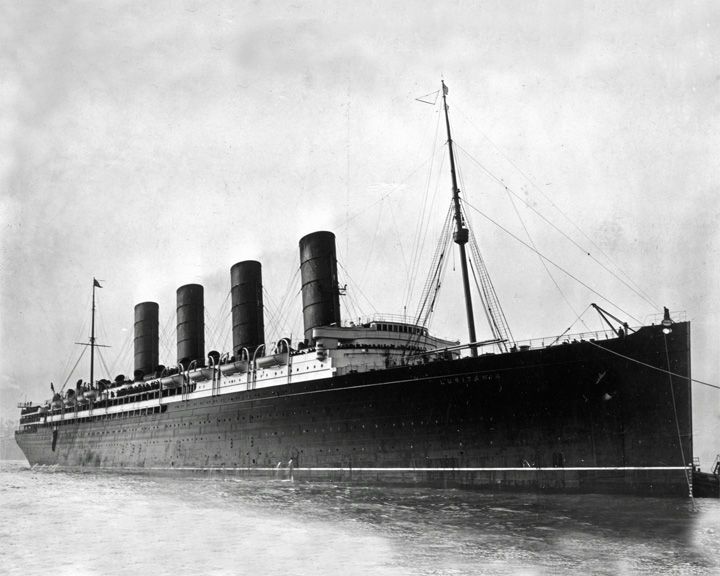 (Another (Another Lusitania, RMS — British ocean liner Torpedoed by German submarine U-20, killing 1,198 people. Her sinking during transatlantic passage turned public opinion against Germany in World War I. LAUNCHED: 1906, June 18 → FATE: Sank 70 kms from the Old Head of Kinsale May 7, 1915. |
 Maggie — British Clyde puffer cargo ship Appeared in the movie The Maggie which was released in the U.S. titled High and Dry. The story is about a clash of cultures between a hard-driving American businessman and a wily Scottish captain. LAUNCHED: 1954, movie release; boat origin unknown → FATE: Inconclusive. |
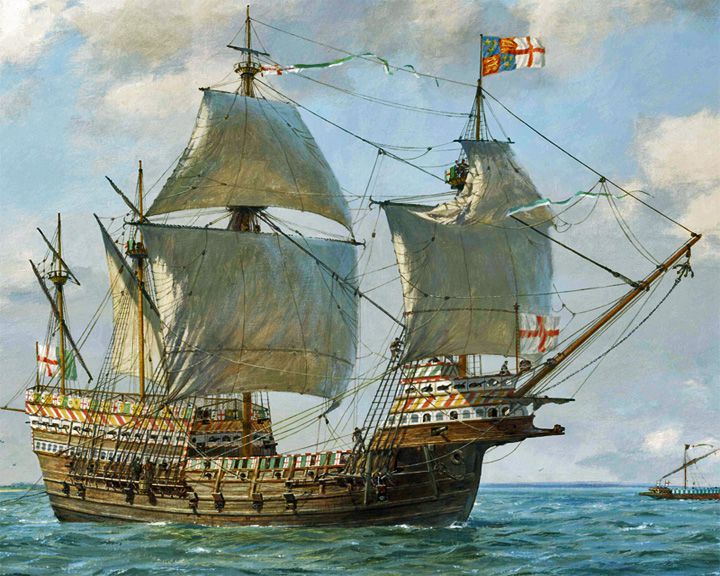 Mary Rose — English carrack-type warship One of the earliest ships built for war sporting the innovation of gun ports. The wreck of the Mary Rose was rediscovered in 1971 and salvaged in 1982. LAUNCHED: 1512 → FATE: Sank in the straits north of the Isle of Wight, 1545. |
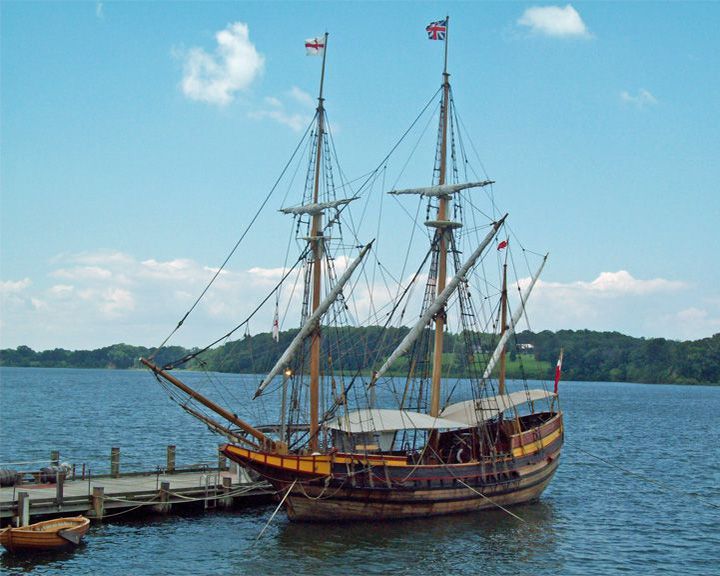 Maryland Dove — American merchant vessel Replica of the Dove, one of two early 17th-century English ship that, in 1634, brought the first settlers to what is now Maryland. The original Dove was the smaller of the two ship, used in shallow waterways along the coast. The accompanied ship with 140 passengers was the Ark. LAUNCHED: 1978, August 18 → FATE: On exhibit at Historic St. Mary's City and occasionally other ports. |
 Matthew — English caravel Sailed by John Cabot, first European to reach North America. Apparently, she was a small ship of fifty tons carrying twenty men and food for seven or eight months. LAUNCHED: 1496, or earlier; replica launched 1996 → FATE: Original ship, unknown; replica on display at M Shed Museum, Bristol, England. |
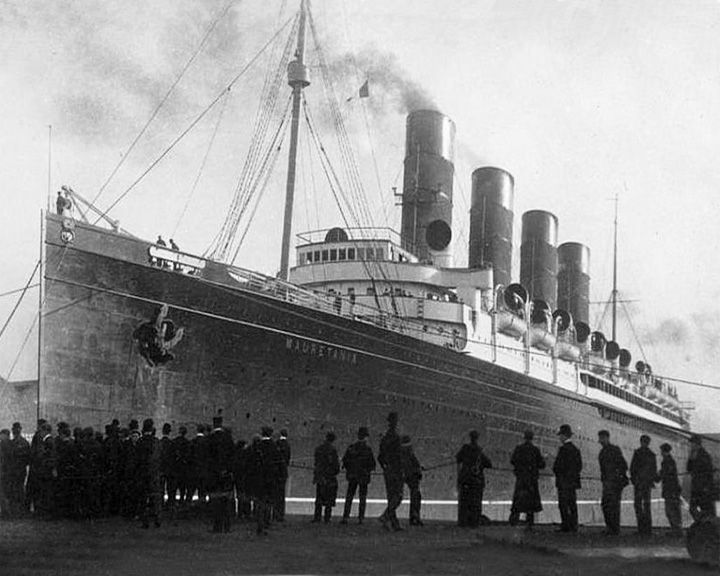 Mauretania, RMS — British ocean liner At the time, she was the largest and fastest ship in the world. She made an eastbound transatlantic crossing with a long-standing record average speed of 23.7 knots. She served as a hospital ship and troop ship in World War I. LAUNCHED: 1906, September 18 → FATE: Scrapped in 1934. |
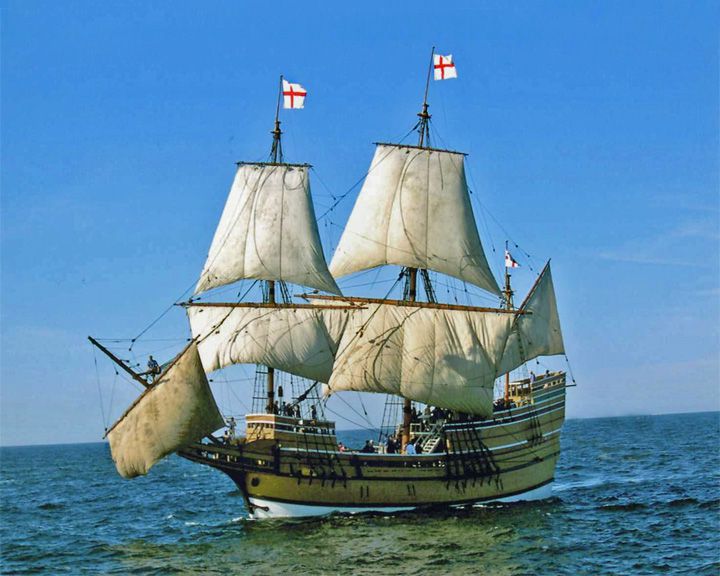 Mayflower — English galleon Transported the English Pilgrims from England to Plymouth, Massachusetts in 1620. The ocean crossing took 66 days. A second ship called the Mayflower made a voyage from London to Plymouth Colony in 1629. LAUNCHED: 1607, about → FATE: Sold and taken apart in May of 1624. |
|
Page 10
|
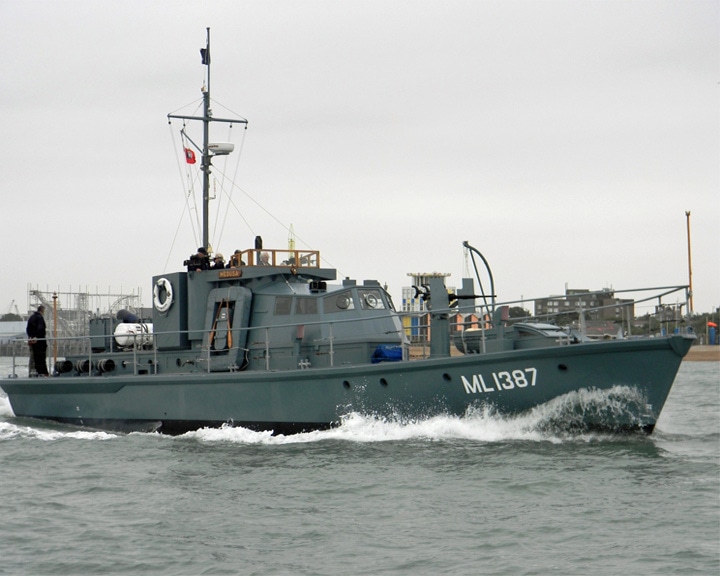 Medusa, HMS — British Harbour defence motor launch She served at D-Day as a Navigation Leader, marking German minefields to be cleared by minesweepers, and then staying at the entrance of the cleared channel to direct parts of the invasion force. For more, see Museum Ships. LAUNCHED: 1943 → FATE: On exhibit at Gosport in England. |
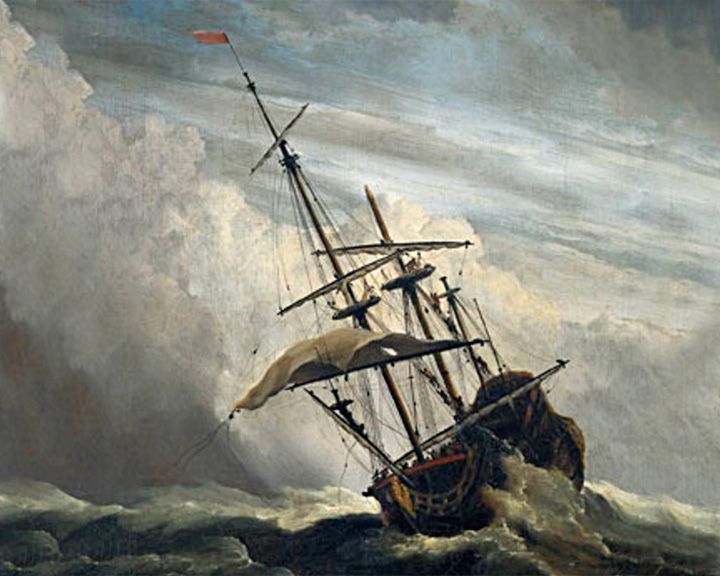 Merchant Royal — English merchant ship Lost at sea with 18 men off Land's End, Cornwall, England, the ship is one of the richest sunken treasures. Lost were more than half million Spanish silver pesos, 500 bars of gold and ingots of silver, and hundreds of pieces of jewelry. LAUNCHED: 1627 → FATE: Sank in bad weather September 23, 1641. |
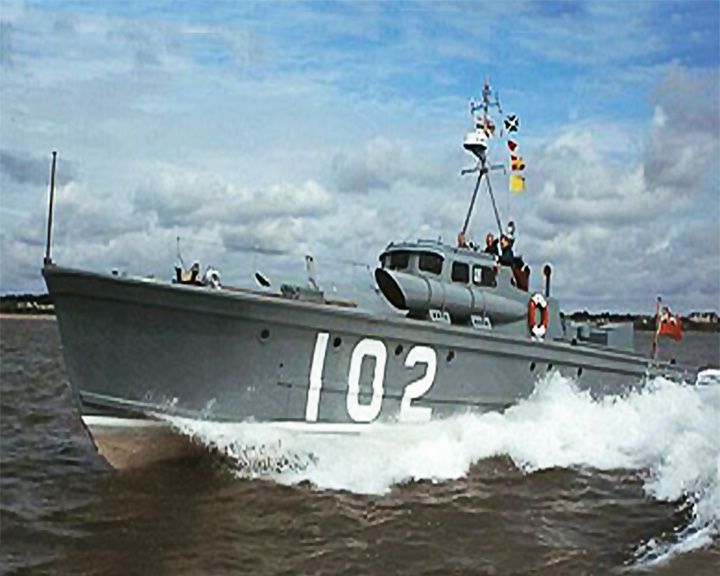 MTB 102 — British motor torpedo boat The the fastest wartime British naval vessel in service at 48 knots and the smallest vessel to ever serve as a flagship for the Royal Navy. In 1944 she carried Winston Churchill and General Eisenhower to review the fleet for Operation Overlord, the invasion of Normandy, World War II. She appeared as herself in the 2017 war film Dunkirk. LAUNCHED: 1937 → FATE: On exhibit at Lowestlft, on the North Sea. |
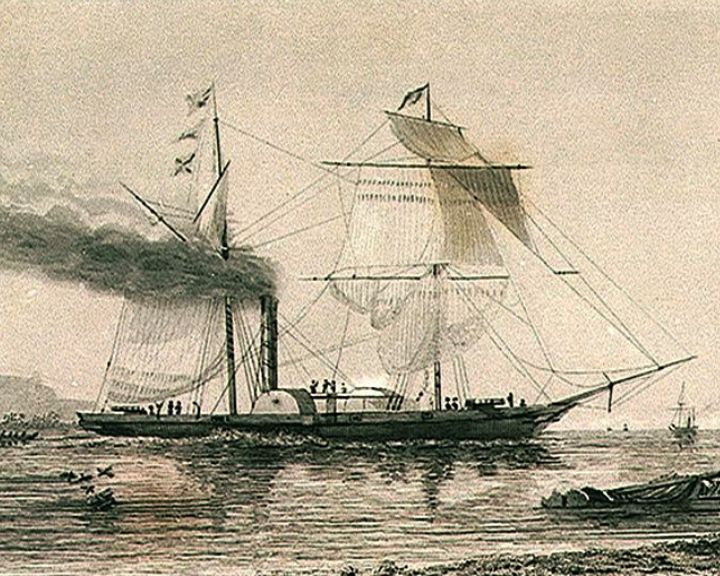 Nemesis — British steam and sail powered warship The first British ocean-going iron warship; also the first iron ship to sail around the Cape of Good Hope. She was greatly effective in the First Opium War. The Chinese referred to her as the "devil ship". LAUNCHED: 1839 → FATE: Ended up in Calcutta, 1855. |
 Orion, RMS — British ocean liner First to offer modern passenger comforts in ocean travel including air conditioning.. She was launched at England from Brisbane, Australia by wireless remote by the Duke of Gloucester. She served as a troop ship in World War II, then converted to a passenger liner in 1946. LAUNCHED: 1934, December 18 → FATE: Broken for scrap at Antwerp, Belgium in 1963. |
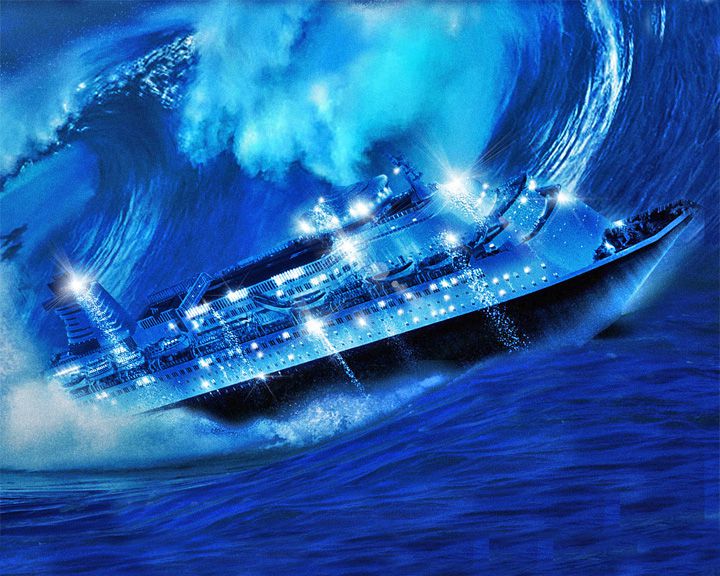 Poseidon, SS — American cruise ship; British ocean liner Subject of a ship sinking in the 1969 novel The Poseidon Adventure and four movie adaptations, 1972, 1979, 2005, and 2006. In each version of the story, the ship is capsized and several survivors try to make their way to the top of the overturned ship. LAUNCHED: 1969, original story → FATE: Inconclusive. |
 President, SS — British paddle steamship, with sails; ocean-going First steamship lost at sea on a transatlantic run, taking with her all 136 on board. Constructed with a third deck on top of the hull and designed with luxurious staterooms, she was top heavy and rolled excessively. LAUNCHED: 1840, August → FATE: Lost during a gale off Nantucket Shoals March of 1841. |
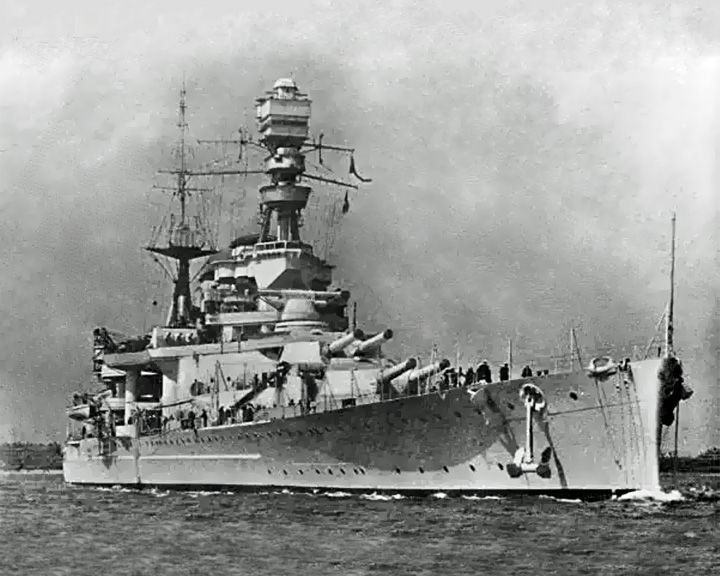 Prince of Wales, HMS — British battleship She and Repulse were the first capital ships to be sunk solely by naval air power on the open sea. She was involved in several key actions of the World War II, including the Battle of the Denmark Strait against the German battleship Bismarck. LAUNCHED: 1939, May 18 → FATE: Sunk on December 10, 1941 by Japanese air attack off Kuantan, South China Sea. |
|
Page 11
|
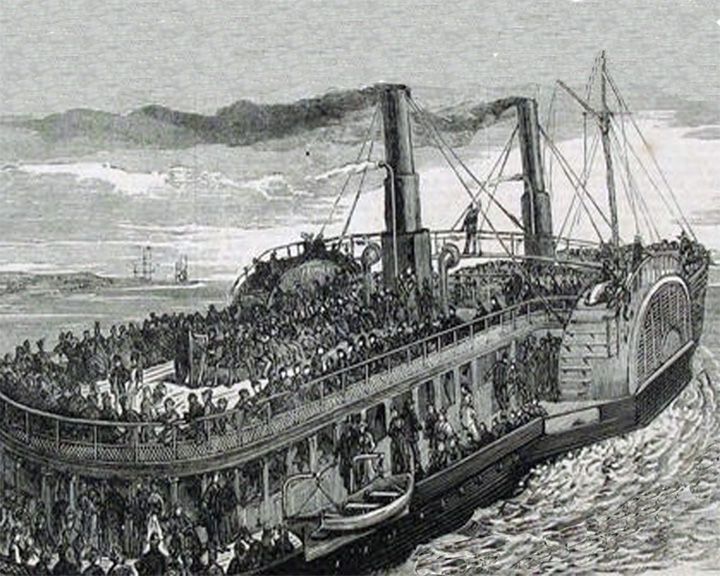 (Another (Another Princess Alice — British paddle steamer The greatest loss of life, 600-700, of any British inland waterway shipping accident after being struck by the Bywell Castle. Because of the river pollution from the sewage and local industrial output, the recovered bodies were covered with slime and toxins. LAUNCHED: 1865, July → FATE: Sank on September 3, 1878 after the collision on the River Thames. |
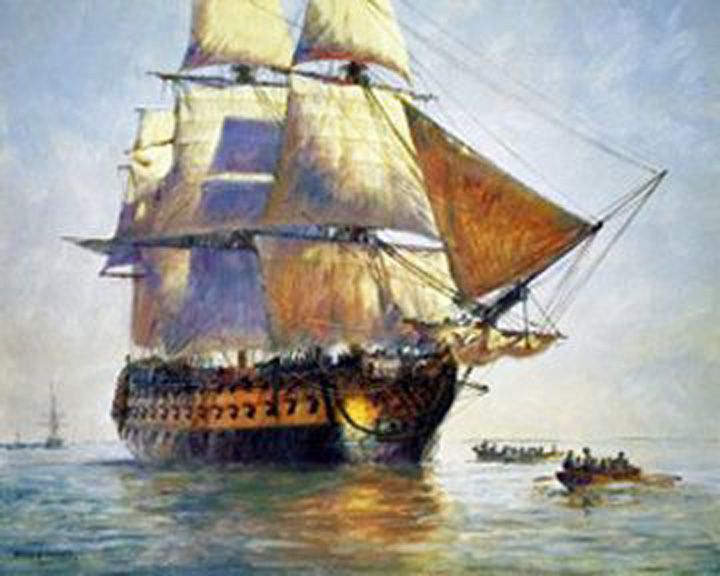 (Another (Another Queen Anne's Revenge — English sloop Flagship of pirate Blackbeard (Edward Thatch). As Conccord was captured by the French in 1711, and then as La Concord she was taken by pirates in 1717. LAUNCHED: 1710 → FATE: Run aground near Beaufort Inlet, North Carolina in May, 1718. |
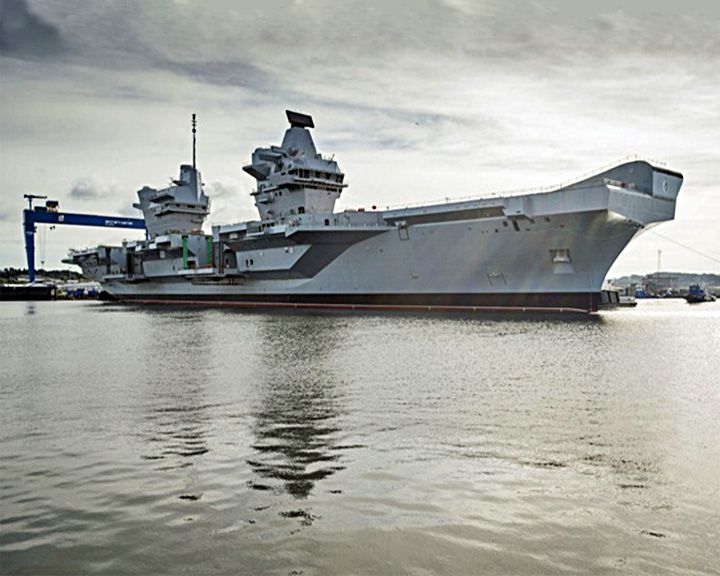 Queen Elizabeth, HMS — British aircraft carrier Largest warship ever built for the Royal Navy capable of carrying up to 40 aircraft. With no catapults and catch wires she carries only V/STOL aircraft, F-35B Lightning II fighters and Merlin helicopters. LAUNCHED: 2014, July 18 → FATE: In service 2017. |
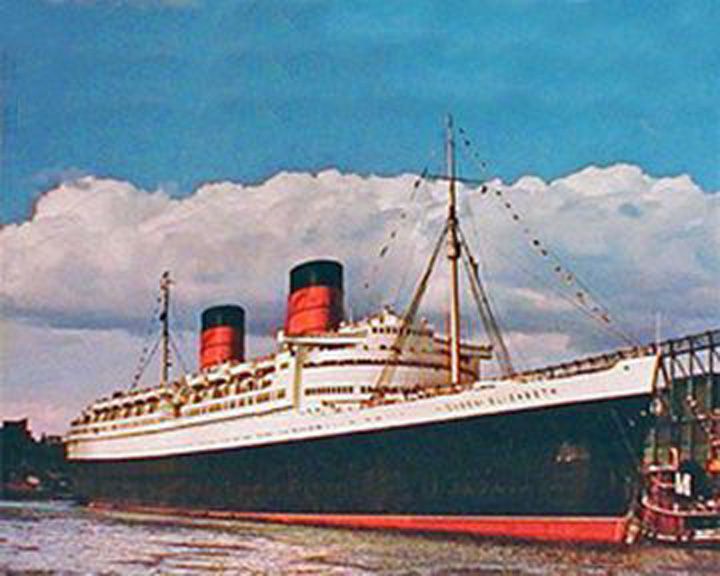 (Another (Another Queen Elizabeth, RMS — British ocean liner With sister ship Queen Mary, dominated the transatlantic passenger service. She was used in World War II as troop transport. After being converted to a university and renamed Seawise University, she was destroyed by fire. The charred wreck was featured in the 1974 James Bond movie The Man with the Golden Gun. LAUNCHED: 1938, September 18 → FATE: After a fire, capsized in Hong Kong Harbor, January 9, 1972. |
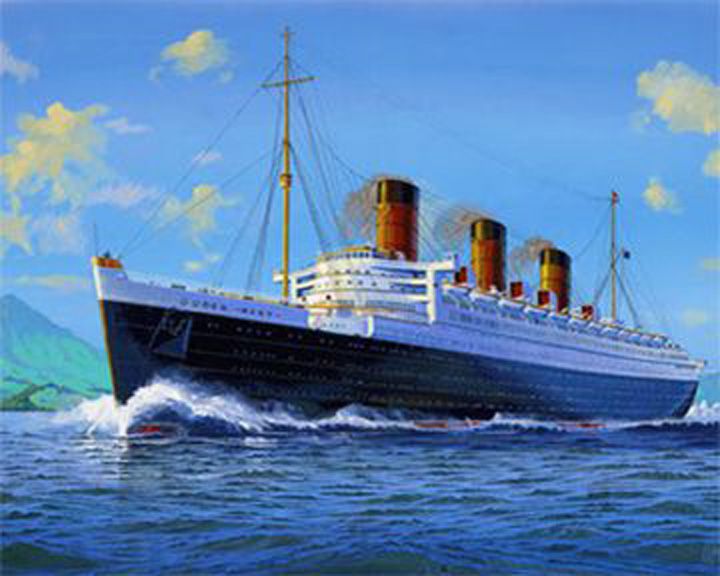 Queen Mary, RMS — British ocean liner Once dominated transatlantic passenger service with sister ship Queen Elizabeth. She was used in World War II as troop transport carrying up to 15,000 passengers at a time. Featured in the 1972 movie The Poseidon Adventure and the 1981 movie Goliath Awaits. LAUNCHED: 1934, Septmber 26 → FATE: After sailing nearly 4 million miles, she was retired in 1967 and berthed in Long Beach, California as a museum ship and hotel from 1974 to present. |
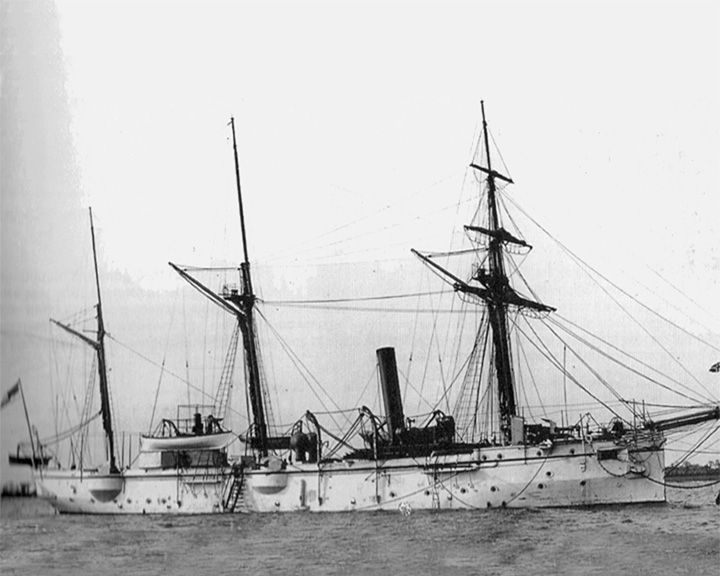 Rattler, HMS — British sloop made of wood with metal frame First warship to adopt a screw propellor. In March 1845, she beat HMS Alecto in a series of races, followed by a contest in which she towed Alecto backwards at a speed of 2 knots (3.7 km/h). LAUNCHED: 1843 → FATE: Broken up 1856. |
 Resolution, HMS — British Collier The first ship to cross the Antarctic Circle reaching beyond latitude 71 degrees south. She was the ship on which Captain James Cook made his second and third voyages of exploration in the Pacific. LAUNCHED: 1770 → FATE: Taken by the French June 10, 1782, renamed La Liberté and ended up rotting in Narragansett Bay not far from Cook's other ship, Endeavour. |
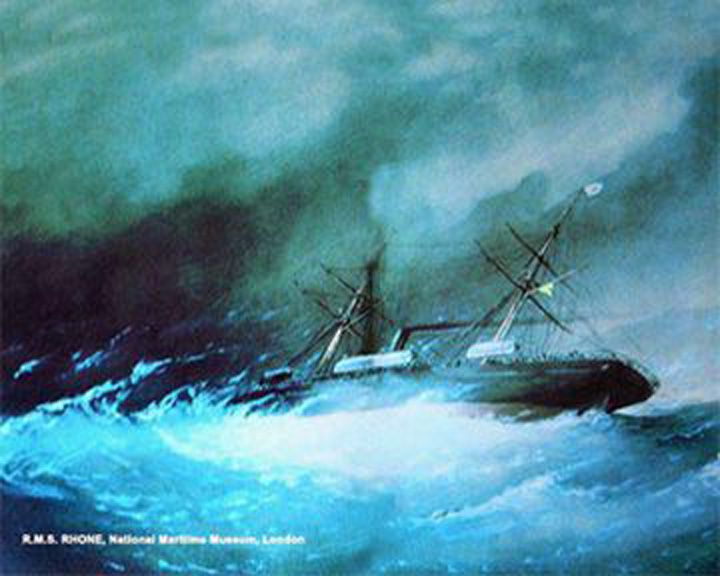 (Another (Another Rhone, RMS — British packet ship Sunk during a hurricane with the loss of approximately 123 lives. The wreckage is now a popular diving site and was used in the 1977 film The Deep that featured Jacqueline Bisset in a wet T‑shirt. LAUNCHED: 1865 → FATE: Wrecked in the British Virgin Islands on October 29, 1867. |
|
Page 12
|
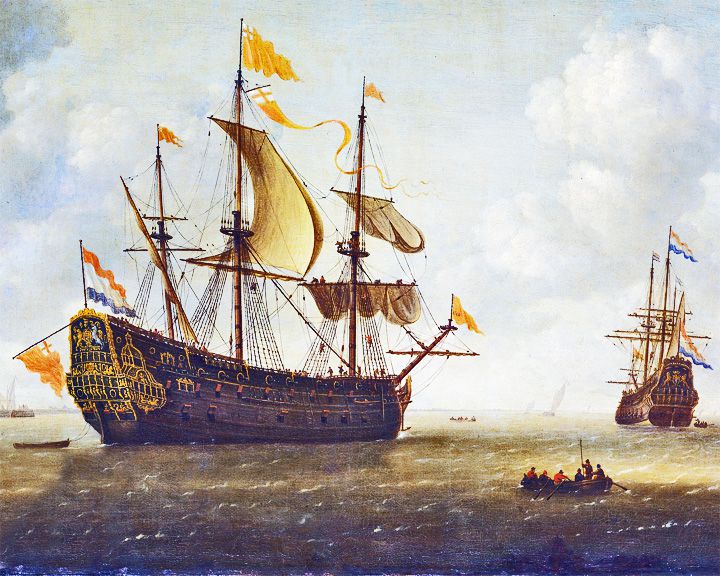 Royal Charles, HMS — British first-rate three-decker ship of the line During the English Restoration, she brought Charles II and his entourage from the Dutch Republic to England to reclaim his crown. At 1,229 tons, she was larger than Sovereign of the Seas, the first three-deck ship of the line. LAUNCHED: 1655, April 18 → FATE: Sold for scrap in 1673 by Dutch navy. |
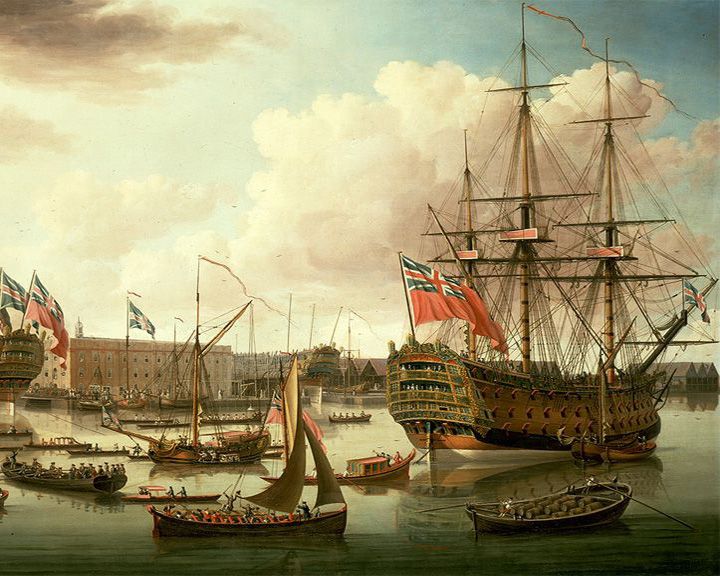 Royal George, HMS — English first-rate ship of the line One of the most serious maritime losses to occur in British water, sinking while undergoing routine maintenance taking more than 800 lives. She was the largest warship in the world at the time of launching. LAUNCHED: 1756, February 18 → FATE: Sank while anchored off Portsmouth August 29, 1782. |
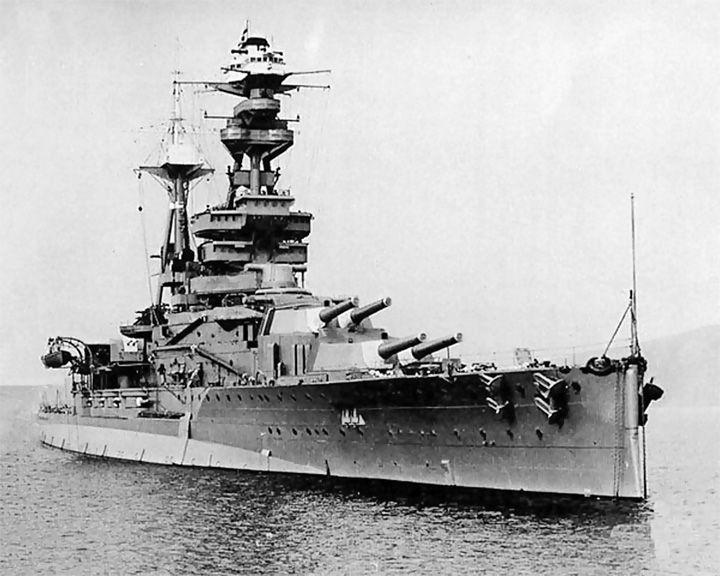 (Another (Another
Royal Oak, HMS — British Battleship, Revenge-class The first of five Royal Navy battleships and battlecruisers sunk in the World War II. When she was torpedoed, 835 of her 1,234 crew were killed. The brass letters of her name were removed from the sunken ship and are now displayed in the Scapa Flow visitor center. LAUNCHED: 1914, November 17 → FATE: Was sunk in Scapa Flow in October 1939 by a German U-boat, |
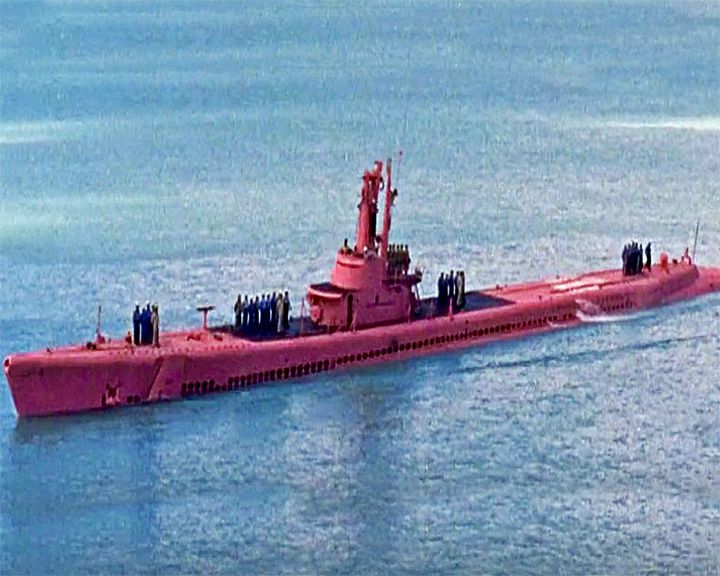 (Another (Another Sea Tiger, USS — American submarine A fictional U.S. Navy submarine in the 1959 movie Operation Petticoat during the opening days of World War II. Stand-in boats were USS Balao painted pink for exterior shots and USS Archerfish with the standard colors of gray and black for interior and some exterior shots. LAUNCHED: 1959 → FATE: Inconclusive. |
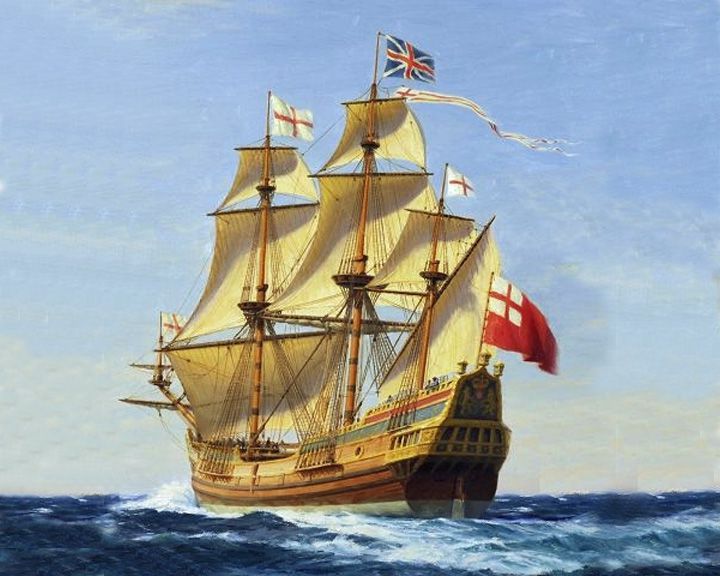 Sea Venture — English merchant ship; purpose-built First dedicated emigration ship as part of the Third Supply mission to the Jamestown Colony. During the storm, massive leaks developed because of faulty construction. All 150 people aboard and one dog made it to shore safely. LAUNCHED: 1609 → FATE: Damaged in a hurricane and scuttled at Discovery Bay, June 1609. |
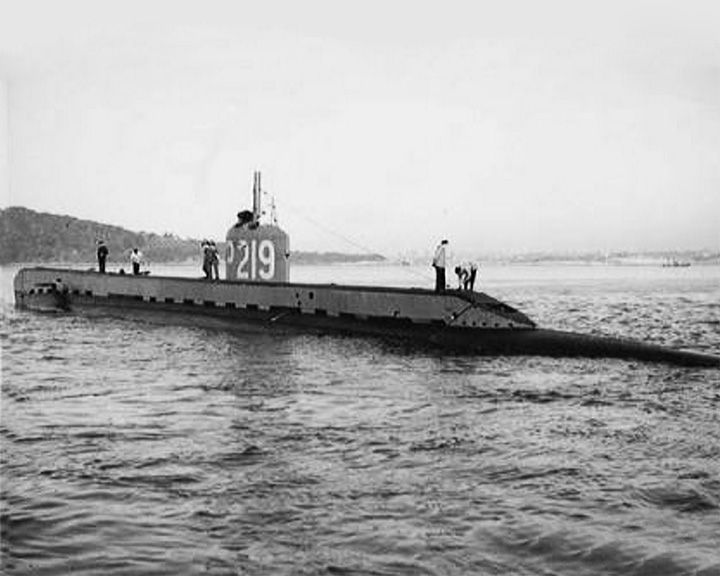 Seraph, HMS — British submarine Known as "the ship with two captains," briefly became the USS Seraph. During World War II, she released a corpse ("The Man Who Never Was") onto the shores off Gibraltar carrying decoy papers to fool the Nazis as part of "Operation Mincemeat." LAUNCHED: 1941, October 18 → FATE: Scrapped in December of 1962. |
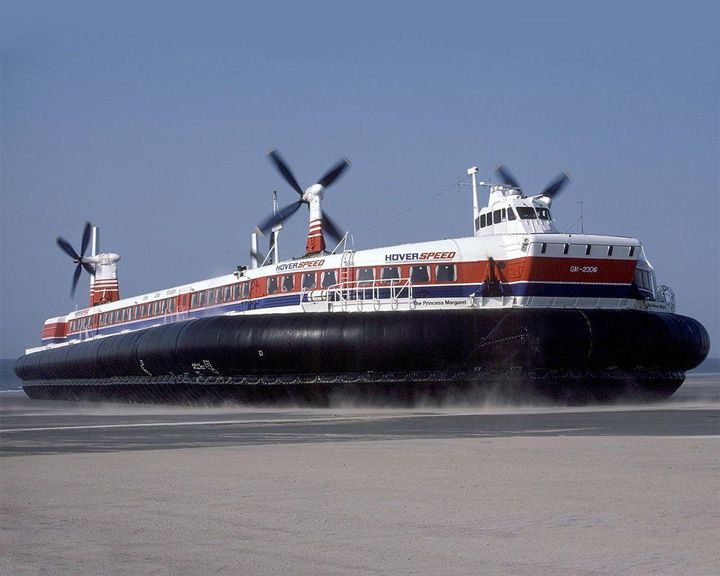 SN.R4 — British Mountbatten class hovercraft Was the largest civil hovercraft ever built, carrying 254 passengers and up to 30 cars. She is the only surviving hovercraft that served English Channel traffic from 1968 to 2000. The others, Sir Christopher, Sure, Swift, Princess Margaret, and The Prince of Wales, were all scrapped. LAUNCHED: 1968 → FATE: Preserved and on static display at the Hovercraft Museum at Lee-on-Solent, England. |
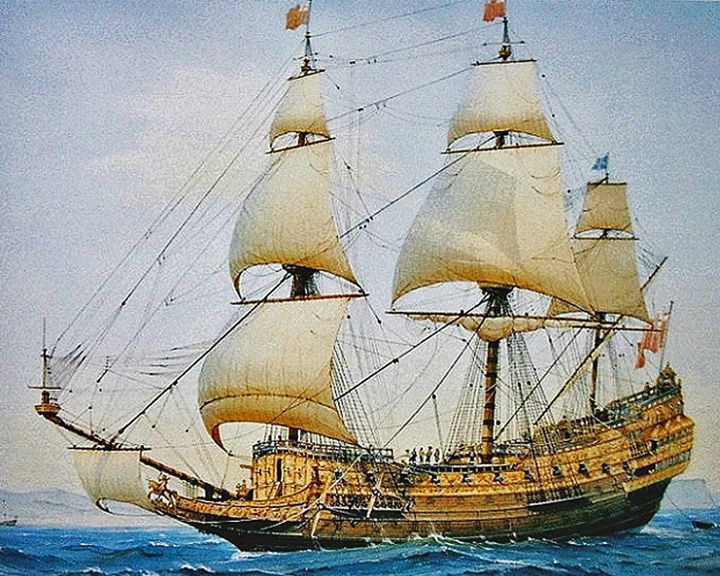 Sovereign of the Seas, HMS — English full-rigged warship The most extravagantly decorated warship in the early Royal Navy. She was armed with 102 bronze guns at the insistence of the king, Charles I of England. LAUNCHED: 1637, October 18 → FATE: Burnt to the water line January 27, 1697. |
|
Page 13
|
 (Another (Another Spirit of Chartwell, MV — English hotel barge The Royal Barge used for Queen Elizabeth II's Diamond Jubilee, June 3, 2012. She originally sailed the Rhine River as the Van Gogh, designed to sail the waterways of Europe and venture into coastal waters. She was refitted in for the 2011 jubilee. LAUNCHED: 2009 → FATE: Still afloat. |
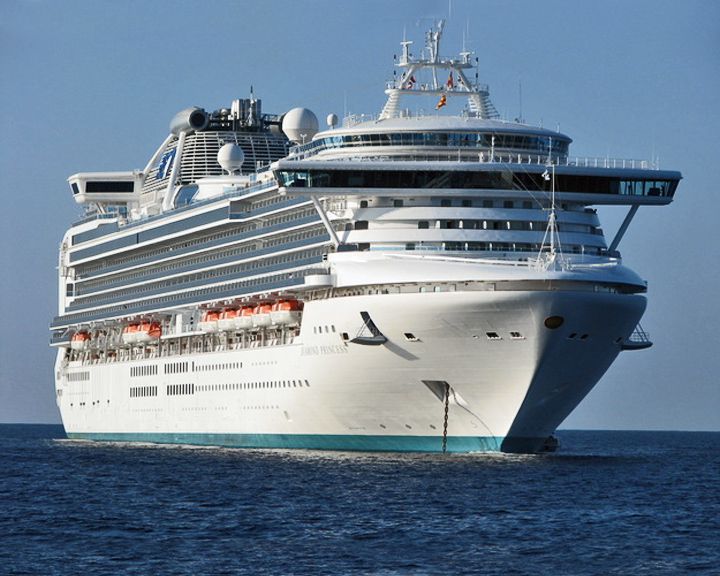 (Another (Another Star Princess — Italian cruise ship; American-British owned Fire amidship produced smoke, killing one passenger and injuring 13 others. With the fire initiated, highly combustible polycarbonate partitions, polyurethane deck tiles, and the plastic furniture produced large amounts of thick black smoke. LAUNCHED: 2001, May 18 → FATE: Damage repaired and still in service. |
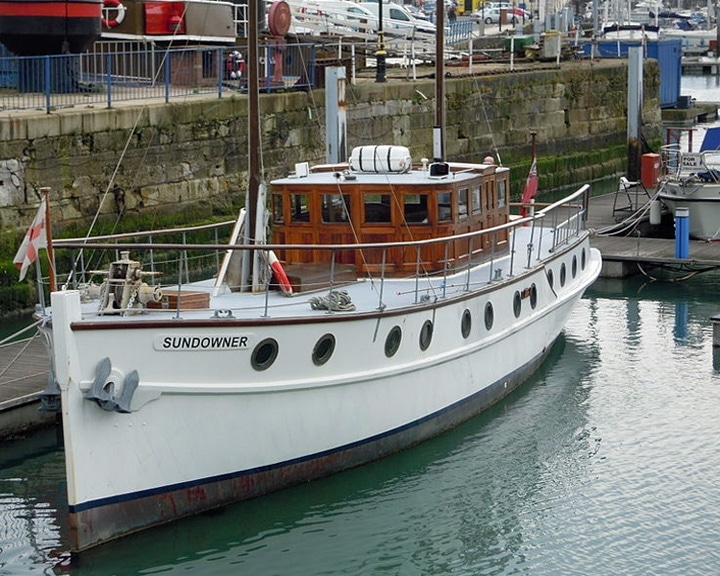 Sundowner — British motor yacht She participated in the Dunkirk evacuation as one of the "little ships" as well as a number of commemorations of the event. She was formerly owned by Charles Lightoller who was Second Officer aboard the ill-fated RMS Titanic and survived. LAUNCHED: 1912 → FATE: A museum ship at the Ramsgate Maritime Museum in Southern England. |
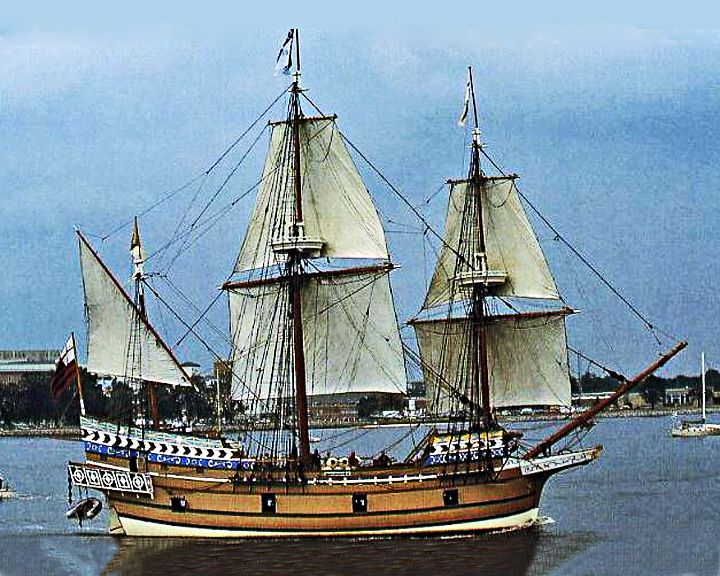 Susan Constant — British fully-rigged ship The largest of three ships of the English Virginia Company sailing to establish the new Colony of Virginia, Jamestown. Replicas of Susan Constant, shown in image, and her sister-ships are docked in the James River at Jamestown Settlement. LAUNCHED: 1607 → FATE: After 1615, fate unknown. |
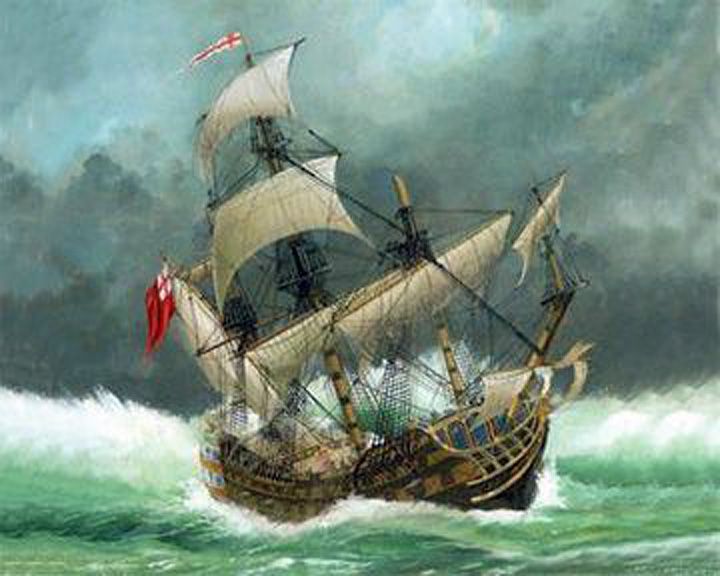 Sussex, HMS — English ship of the line, third-rate One of the most valuable wrecks ever with possibly 10 tons of gold coins and other valuables on board. Besides Sussex, 12 other ships of her flotilla sank with about 1,200 casualties making the disaster one of the worst in Royal Navy history. LAUNCHED: 1693, April 18 → FATE: Sank in a violent storm near the Strait of Gibraltar February 27, 1694. |
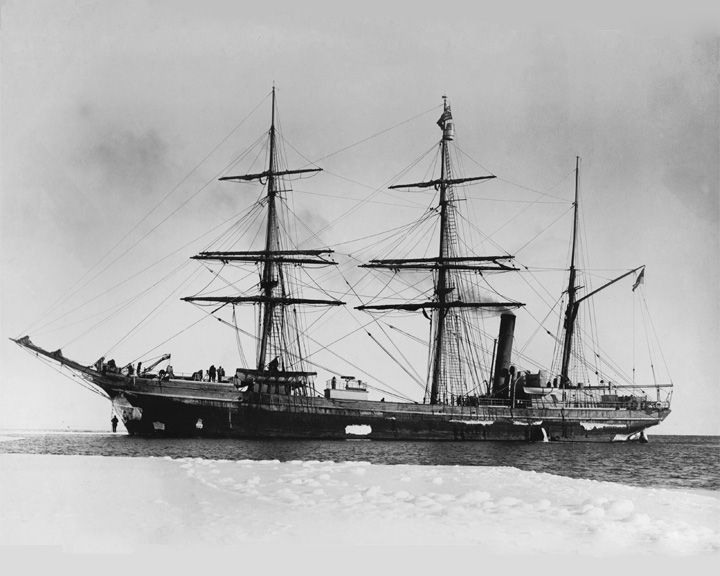 Terra Nova — British wooden-hulled barque Serving in the British Antarctic Expedition 1910, best remembered for the death of Captain Scott and four companions. She was built for the Dundee whaling and sealing fleet, working 10 years in the annual seal fishery in the Labrador Sea. LAUNCHED: 1884 → FATE: Sank off the southwestern tip of Greenland September 13, 1943. |
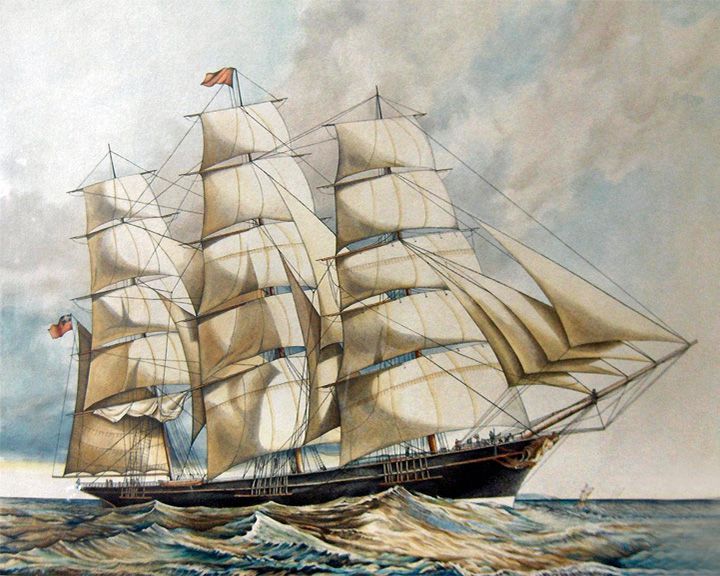 Thermopylae — English extreme clipper Raced the clipper Cutty Sark from Shanghai back to London and won by seven days. In 1897, she was sold to Portugal and renamed Pedro Nunes for used as a naval training ship. LAUNCHED: 1868, August → FATE: Sunk as target practice by the Portuguese Navy, October 13, 1907. |
 (Another (Another Titanic, RMS — British luxury ocean liner The most famous ship sinking in history, she sank after hitting iceberg in the Atlantic, claiming over 1500 lives. Believed by many to be unsinkable, her disintegrating remains lie at a depth of 3,784 meters. Many movie have been made about her sinking including the 1997 film. LAUNCHED: 1911, May 18 → FATE: Sank in the North Atlantic April 15, 1912. |
|
Page 14
|
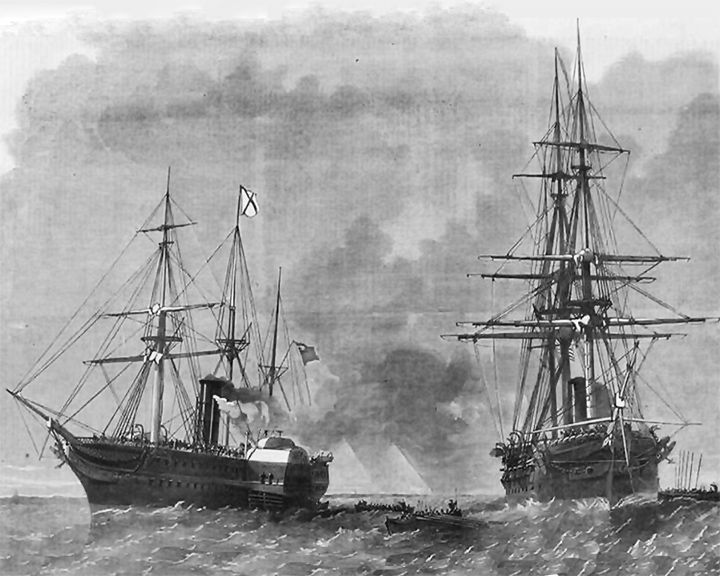 Trent, RMS — British paddle steamer serving as a packet boat Principle ship in the Trent affair in 1861 during the American Civil War. Her interception by USS San Jacinto and unlawfully capture of two Confederate diplomats almost led to war between the Britian and the United States. LAUNCHED: 1841 → FATE: Sold and broken up after 1865. |
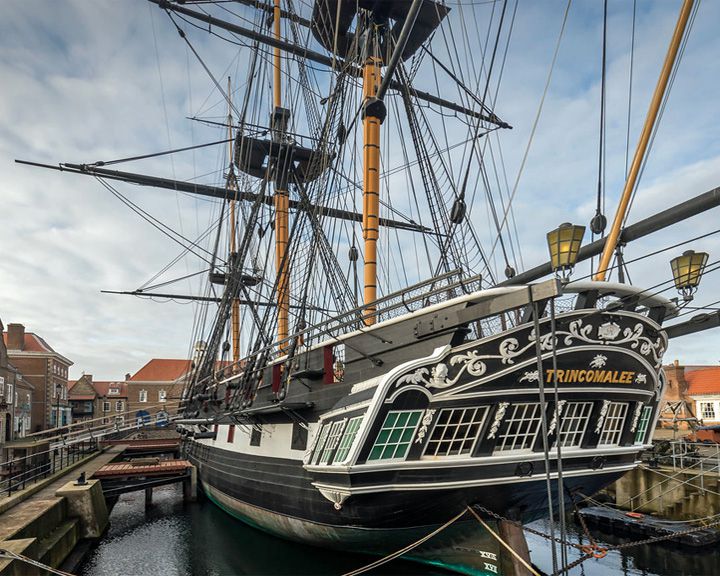 Trincomalee, HMS — British Leda-class frigate One of two surviving British frigates of her era. Holds the distinction of being the oldest British warship still afloat. LAUNCHED: 1817, October 12 → FATE: Restored made the centerpiece museum ship in Hartlepool, England. |
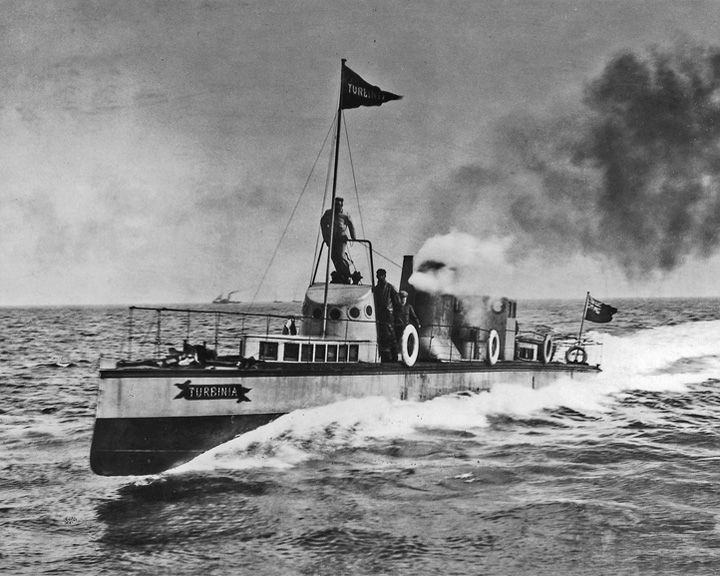 Turbinia — British steamship First steam turbine-powered steamship and the fastest ship in the world at that time at over 34 knots. She showed up unannounced at the Fleet Review for Queen Victoria's Diamond Jubilee at Spithead in 1897, racing up and down the ranks of other ships. LAUNCHED: 1894, August 18 → FATE: On display at the Discovery Museum at Newcastle upon Tyne, England. |
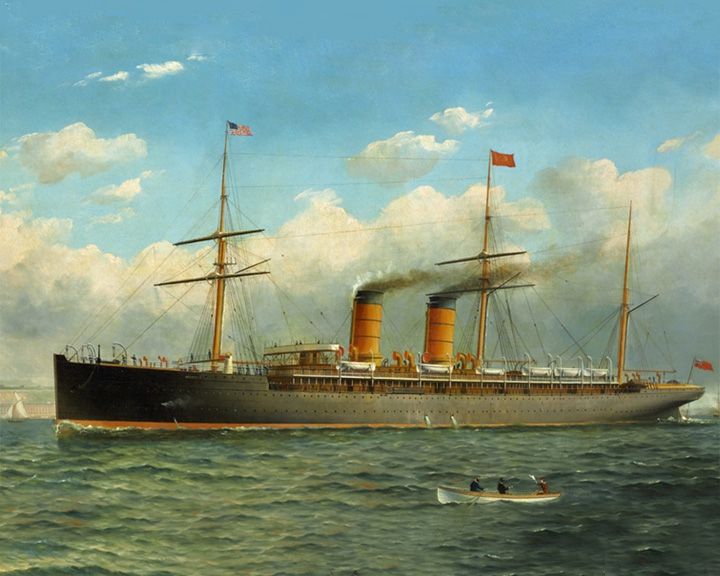 Umbria, RMS — British ocean liner With her sister ship, Etruria, the last two transatlantic ocean liners fitted with auxiliary sails. In May of 1903, the Mafia tried to blow her up but failed. LAUNCHED: 1884, June 18 → FATE: Scrapped in 1910. |
 (Another (Another Unicorn — British three-masted sailing ship Royal Navy vessel appearing in the comics series by Belgian cartoonist Hergé The Adventures of Tintin, and the movie. She is the setting of a battle between pirates and sailors, then scuttled, and discovered years later by the boy Tintin and his friends. LAUNCHED: 1943, first appeared in print; movie release in 2011 → FATE: Inconclusive. |
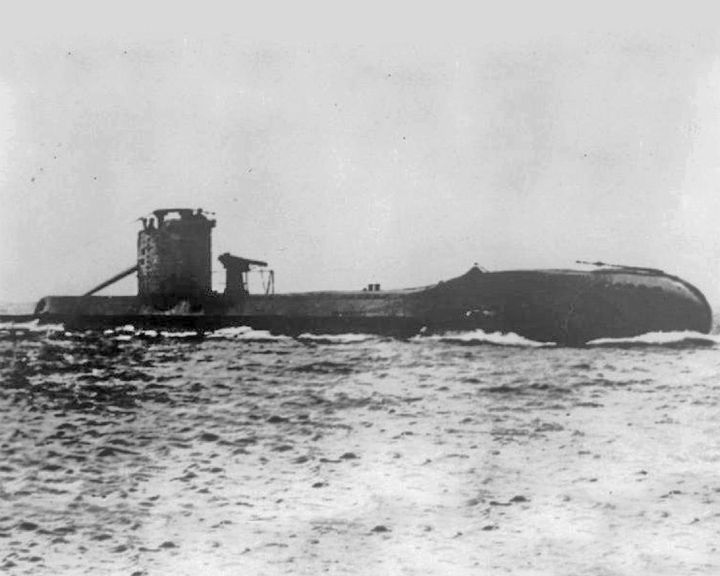 Upholder, HMS — British U-class submarine The most successful British submarine of the World War II sinking a gross tonnage of 93,031. She was one of four U-class submarines with 2 external torpedo tubes at the bows in addition to the 4 internal ones. LAUNCHED: 1940, July 8 → FATE: Lost northeast of Tripoli with all hands, probably sunk by enemy depth charges April 14, 1942. |
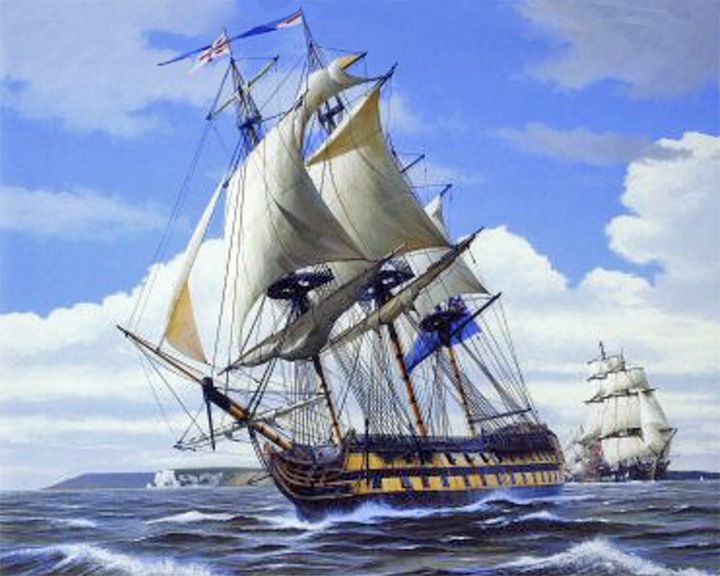 Vanguard, HMS — English ship of the line, 74-gun third-rate The flag ship of Horatio Nelson at the Battle of the Nile, 1798. Prince Alberto of Naples and Sicily, part of a royal entourage on board fleeing from Naples and the French, died on board. LAUNCHED: 1787, March 18 → FATE: Broken up in 1821. |
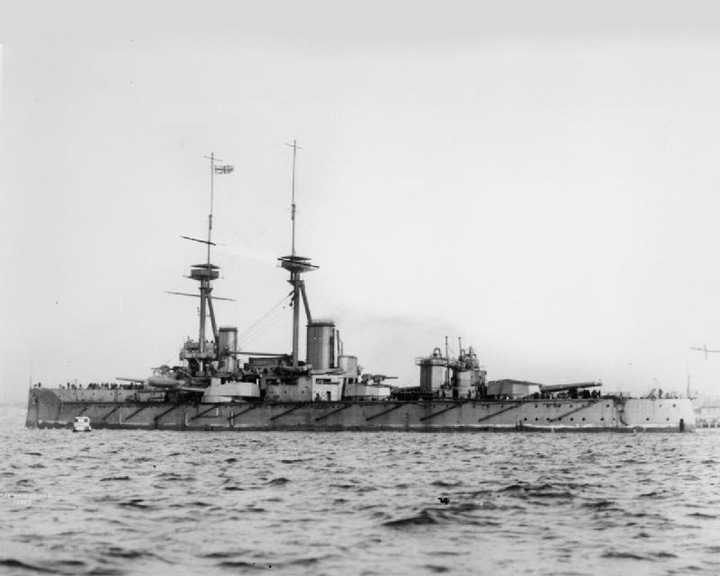 Vanguard, HMS (1909) — British St. Vincent class Dreadnaught She suffered a series of magazine explosions, sinking almost instantly, killing 843 of the 845 men aboard. Her captain coincidentally made a speech to the crew predicting the possible fate of the ship several hours before her sinking. Vanguard's wreck was heavily salvaged in search of non-ferrous metals before it was declared a war grave in 1984. Royal Navy divers placed a new Union Jack on the wreck. LAUNCHED: 1909, February 2 → FATE: Sunk by internal explosion at Scapa Flow, July 9, 1917. |
|
Page 15
|
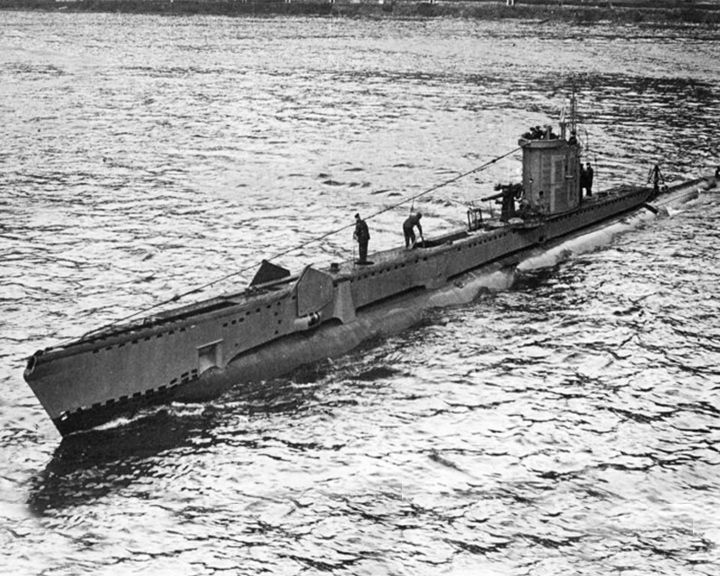 Venturer, HMS — British V-class submarine First time in naval warfare that one submarine stalked and sank another while both were submerged. Based on Enigma decrypts, she sought out and destroyed the German submarine U-864 in the Fedje area, February 9, 1945. LAUNCHED: 1943, May 4 → FATE: She was sold to Norway and renamed HNoMS Utstein. She was scrapped and broken up in 1964. |
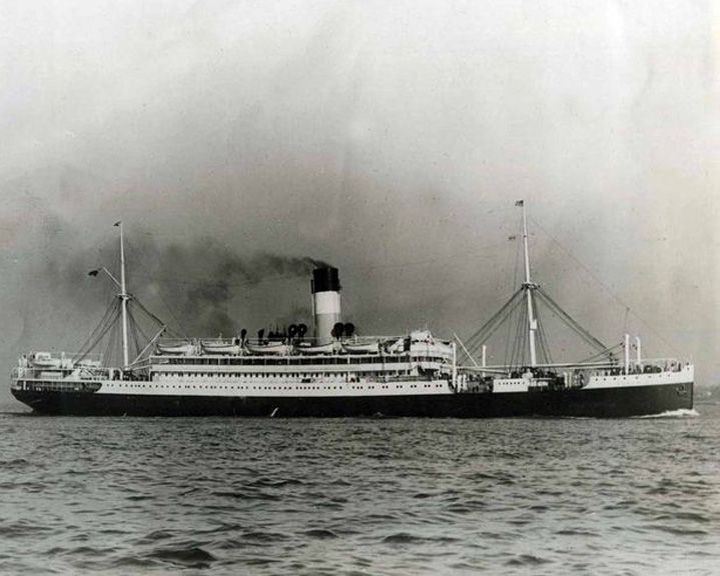 Vestris, SS — British passenger steamship The ship sank taking more passengers to their death than crew. 60 of 128 passengers survived, 155 of 198 crew survived. None of 13 children and only 8 of 33 women survived. LAUNCHED: 1912, May → FATE: Sank November 12, 1928. |
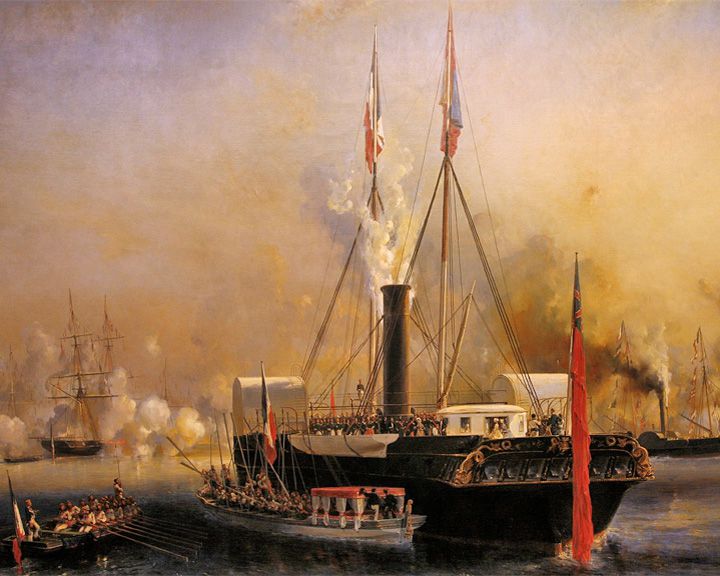 Victoria and Albert, HMY — British royal yacht; twin-paddle steamer First steam powered royal yacht built in Britain. The Queen and Prince Albert loved cruising around the coast of England. The yacht was renamed Osborne after the launch of HMY Victoria and Albert II January 16, 1855. LAUNCHED: 1843, April 25 → FATE: Scrapped, 1868. |
 Victory, HMS — English first-rate ship of the line (Galleon) Lord Nelson's flagship at the Battle of Trafalgar in 1805. She was refitted and repainted in 1800-1803, almost broken up in 1831, fitted up as a Naval School 1889, retired in 1904, and eventually restored. LAUNCHED: 1765, May 18 → FATE: Being restored at the HMNB, Portsmouth, England. |
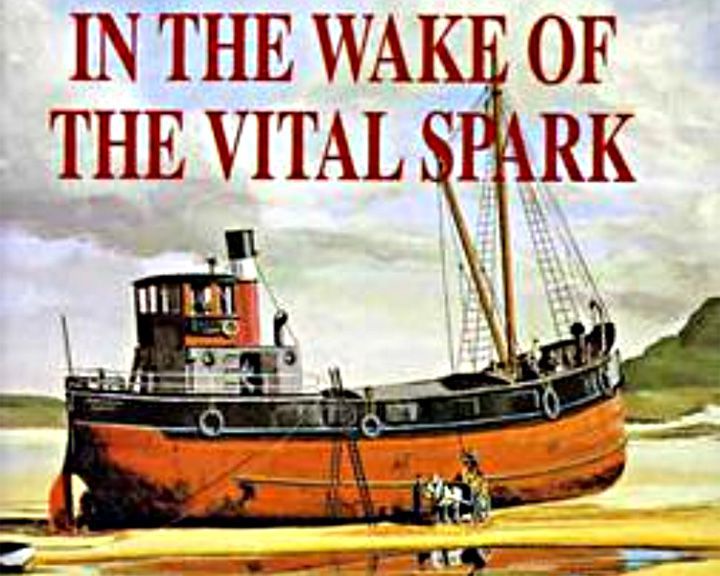 (Another (Another Vital Spark — British Clyde puffer cargo ship Star of the book series and British TV comedy series, The Vital Spark about the adventures of the boat captain and his crew. The BBC Scotland TV program The Vital Spark (1959-1974 series) was set in the western isles of Scotland in the 1930s, based on the books by Neil Munro LAUNCHED: 1931, book published; 1959 for the start of TV series; boat built in 1943 → FATE: The boat is to be restored as a tourist attraction with the Inveraray Maritime Museum. |
 Warrior, HMS — British warship First British iron-hulled, armour-plated warship. She was the largest, fastest, most heavily armed and armored warship up to that time. LAUNCHED: 1860, December 18 → FATE: Currently berthed in Portsmouth, England as a museum. |
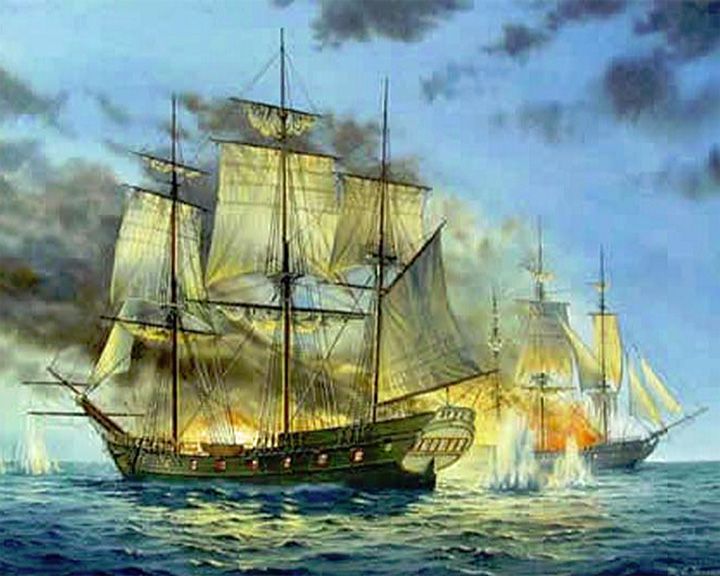 Whydah Gally — British sailing ship, square rigged three-masted Flagship of the pirate "Black Sam" Bellamy. The wreck was found in 1984. Artifacts from the wreck are on display at The Whydah Pirate Museum in Provincetown, Massachusetts. LAUNCHED: 1715 → FATE: Sank in a violent storm April 26, 1717. |
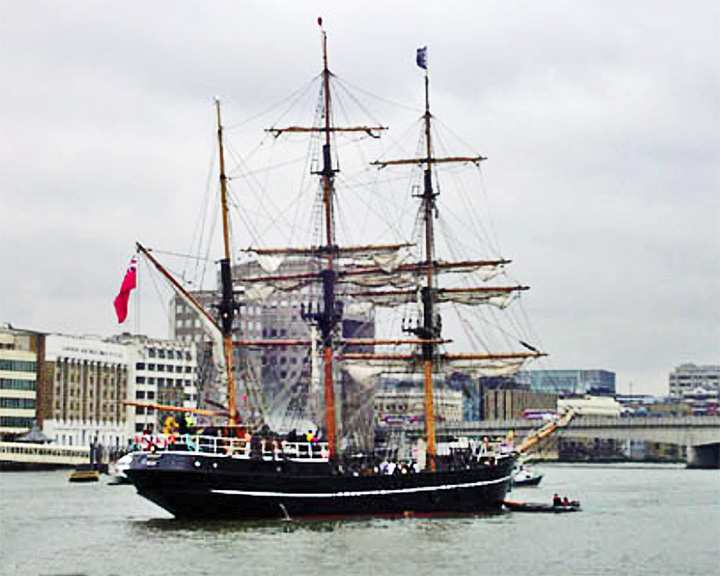 Zong — British square rigger slave ship Infamous for the 1781 massacre of 132 sick and dying slaves thrown overboard so the ship's owners could collect on their cargo insurance. The Zong had been a Dutch vessel the Zorgue seized by the British in 1781 off West Africa, along with 244 Africans on board. LAUNCHED: 1776, or ealier → FATE: Unknown. |
The number of British/English Ships and Boats listed is 119 The contents of this page are available under the Creative Commons Attribution-Share Alike 3.0 Unported license and the GNU Free Documentation License (GFDL). |
|
|
First Ship on each page
| |
| Page | Ship Name (Country and Type) |
| 1. | Amethyst, HMS (British modified Black Swan class sloop) |
| 2. | Atlantic, RMS (English ocean liner) |
| 3. | Britannic, HMHS (British ocean liner) |
| 4. | City of Benares, SS (British steam passenger ship) |
| 5. | Devastastion, HMS (British Devastation-class ironclad) |
| 6. | Gaspée (English single-masted sloop-of-war) |
| 7. | Great Eastern, SS (British iron paddle steamboat) |
| 8. | Investigator, HMS (British collier) |
| 9. | Lightning, HMS (British torpedo boat) |
| 10. | Medusa, HMS (British Harbour defence motor launch) |
| 11. | Princess Alice (British paddle steamer) |
| 12. | Royal Charles, HMS (British first-rate three-decker ship of the line) |
| 13. | Spirit of Chartwell, MV (English hotel barge) |
| 14. | Trent, RMS (British paddle steamer) |
| 15. | Venturer, HMS (British V-class submarine) |
British/English | |
| 1. | Amethyst, HMS British modified Black Swan class sloop |
| 2. | Archimedes, SS British steamship |
| 3. | Argus, HMS British aircraft carrier |
| 4. | Ark Royal, HMS English galleon |
| 5. | Asgard British yacht |
| 6. | Association, HMS British second-rate ship of the line |
| 7. | Atlantic, RMS English ocean liner |
| 8. | Baychimo, SS German cargo ship |
| 9. | Beagle, HMS English sloop |
| 10. | Belfast, HMS British town-class cruiser |
| 11. | Birkenhead, HMS British frigate |
| 12. | Bluebird K7 British hydroplane |
| 13. | Bounty, HMS English collier |
| 14. | Britannia, HMY British yacht |
| 15. | Britannic, HMHS British ocean liner |
| 16. | Calypso, RV American minesweeper |
| 17. | Campbeltown, HMS American Wickes-class destroyer |
| 18. | Carpathia British ocean liner |
| 19. | Cavalier, HMS British C-class Destroyer |
| 20. | Challenger, HMS British corvette |
| 21. | Champion of the Seas English clipper ship |
| 22. | City of Adelaide English clipper ship |
| 23. | City of Benares, SS British steam passenger ship |
| 24. | Colossus, HMS British third-rate ship of the line |
| 25. | Comet, PS British paddle steamer |
| 26. | Compass Rose British Flower-class corvette |
| 27. | Curacoa, HMS British light-cruiser |
| 28. | Cutty Sark English clipper ship |
| 29. | Darling, HMS British torpedo boat destroyer |
| 30. | Derbyshire, MV British cargo ship |
| 31. | Devastastion, HMS British Devastation-class ironclad |
| 32. | Discovery British barque |
| 33. | Dreadnought, HMS British dreadnought battleship |
| 34. | Driver, HMS British paddle sloop |
| 35. | Empire Windrush, MV German cruise ship |
| 36. | Endeavour, HMS British collier |
| 37. | Etoile du Roy British frigate |
| 38. | Furious, HMS British battlecruiser |
| 39. | Gaspée English single-masted sloop-of-war |
| 40. | Gaul English fishing trawler |
| 41. | Glencairn, SS British tramp steamer |
| 42. | Gloriana English royal barge |
| 43. | Golden Hind English galleon |
| 44. | Golden Hinde English galleon |
| 45. | Goliath, RMS British ocean liner |
| 46. | Great Britain, SS British steamship |
| 47. | Great Eastern, SS British iron paddle steamboat |
| 48. | Great Western, SS British paddle steamboat |
| 49. | Herald of Free Enterprise, MS British roll-on/rolll-off ferry |
| 50. | Hermione, HMS British frigate |
| 51. | Hero, HMAS British Leander-class frigate |
| 52. | Holland I, HMS British submarine |
| 53. | Hood, HMS British battle cruiser |
| 54. | Hotspur, HMS British sloop-of-war |
| 55. | Investigator, HMS British collier |
| 56. | Invincible, HMS British battlecruiser |
| 57. | K-13 British K-class submarine |
| 58. | Kathleen and May British three masted schooner |
| 59. | Laconia, RMS British ocean liner |
| 60. | Lady Elizabeth British 3-masted iron barque |
| 61. | Lancastria, RMS British ocean liner |
| 62. | LCT7074, HM British landing craft, tank (LCT) |
| 63. | Lightning, HMS British torpedo boat |
| 64. | Lusitania, RMS British ocean liner |
| 65. | Maggie British Clyde puffer |
| 66. | Mary Rose English carrack-type |
| 67. | Maryland Dove American merchant vessel |
| 68. | Matthew English caravel |
| 69. | Mauretania, RMS British ocean liner |
| 70. | Mayflower English galleon |
| 71. | Medusa, HMS British Harbour defence motor launch |
| 72. | Merchant Royal English merchant ship |
| 73. | MTB 102 British motor torpedo boat |
| 74. | Nemesis British steam and sail powered warship |
| 75. | Orion, RMS British ocean liner |
| 76. | Poseidon, SS American cruise ship |
| 77. | President, SS British paddle steamship |
| 78. | Prince of Wales, HMS British battleship |
| 79. | Princess Alice British paddle steamer |
| 80. | Queen Anne's Revenge English sloop |
| 81. | Queen Elizabeth, HMS British aircraft carrier |
| 82. | Queen Elizabeth, RMS British ocean liner |
| 83. | Queen Mary, RMS British ocean liner |
| 84. | Rattler, HMS British sloop made of wood with metal frame |
| 85. | Resolution, HMS British Collier |
| 86. | Rhone, RMS British packet ship |
| 87. | Royal Charles, HMS British first-rate three-decker ship of the line |
| 88. | Royal George, HMS English first-rate ship of the line |
| 89. | Royal Oak, HMS British Battleship |
| 90. | Sea Tiger, USS American submarine |
| 91. | Sea Venture English merchant ship |
| 92. | Seraph, HMS British submarine |
| 93. | SN.R4 British Mountbatten class hovercraft |
| 94. | Sovereign of the Seas, HMS English full-rigged |
| 95. | Spirit of Chartwell, MV English hotel barge |
| 96. | Star Princess Italian cruise ship |
| 97. | Sundowner British motor yacht |
| 98. | Susan Constant British fully-rigged ship |
| 99. | Sussex, HMS English ship of the line |
| 100. | Terra Nova British wooden-hulled barque |
| 101. | Thermopylae English extreme clipper |
| 102. | Titanic, RMS British luxury ocean liner |
| 103. | Trent, RMS British paddle steamer |
| 104. | Trincomalee, HMS British Leda-class frigate |
| 105. | Turbinia British steamship |
| 106. | Umbria, RMS British ocean liner |
| 107. | Unicorn British three-masted sailing ship |
| 108. | Upholder, HMS British U-class submarine |
| 109. | Vanguard, HMS English ship of the line |
| 110. | Vanguard, HMS (1909) British St. Vincent class Dreadnaught |
| 111. | Venturer, HMS British V-class submarine |
| 112. | Vestris, SS British passenger steamship |
| 113. | Victoria and Albert, HMY British royal yacht |
| 114. | Victory, HMS English first-rate |
| 115. | Vital Spark British Clyde puffer |
| 116. | Warrior, HMS British warship |
| 117. | Whydah Gally British sailing ship |
| 118. | Zong British square rigger |
|
About the Data There are more than 400 ships in this database, but the initial list is only for famous ships names that begin with letters "A-B". For other listings, use the country and type tabs. Touching (or cursor over) a ship image produces an enlargement. Touch anywhere else (or move the cursor off the image) to close the larger image. Touching (or clicking on) any underlined name will link to a page with more information. Although submarines are usually called boats, they are grouped with ships here. Most of the information comes from Wikipedia. |
^
Other Pages in Names Galore: | |
Famous Cowboy Names Sports Team Names Other Name Lists | Name Generators Naming Fun Stories about Names |